Gamification, in a nutshell, is taking gaming mechanics and applying them in a non-gaming context. The proper execution of gamification can help boost multiple metrics, from engagement to monetization. According to Duolingo’s former Chief Product Officer Jorge Mazal, leveraging gamification helped Duolingo 4.5x its DAU.
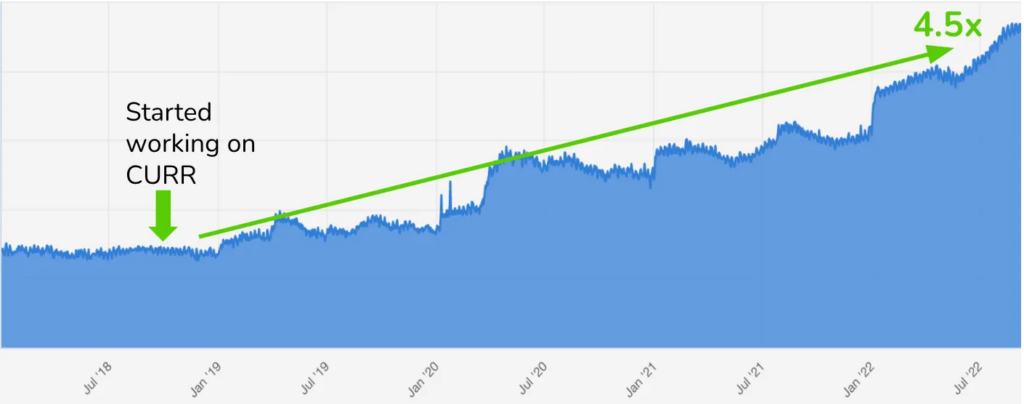
In this deep dive, we look at the growing genre of habit-building self-improvement apps and how gamification can improve the user experience and business goals.
Effective habit-building is hard. Case in point: ambitious New Year’s resolutions that get abandoned within a month. Books that tackle good habit-building, such as Atomic Habits and Tiny Habits, have gained popularity in the last decade. They claim that the key to successful behavioral change is to focus on smaller repetitive tasks that slowly increase in difficulty.
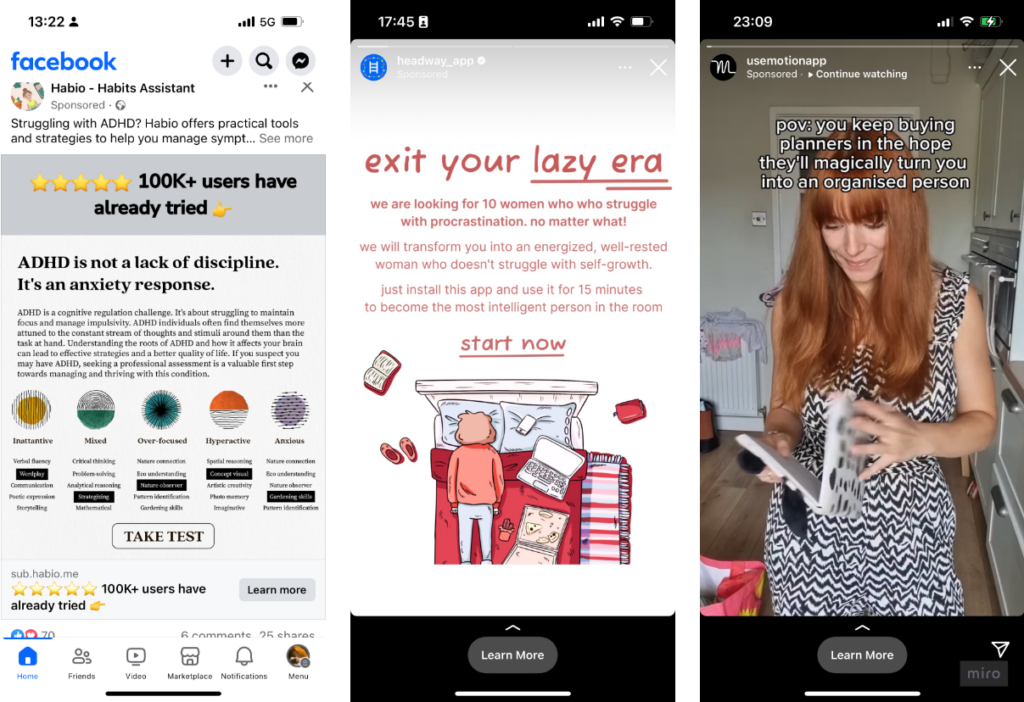
Many companies have translated this into habit-building apps, and have been quite successful. However, we believe there is an opportunity to leverage gamification to enhance the experience, adding a layer of fun and engagement that can both improve user outcomes and monetary success.
In this deep dive, we’ll:
- Discuss gamification and motivation in general.
- Take a look at the current market and define the ongoing trends.
- Compare three gamified habit-building apps: Me+, Daylio, and Finch: Self-Care Pet.
- Summarize the learnings into a recipe for a gamified self-care super app.
Gamification & Motivation
The Concept of Internal and External Motivation
Understanding motivation is essential, as it underpins user engagement and success. It's what compels us to take action, set goals, and work toward achieving them.
By acknowledging and applying motivational principles, developers can create gamified apps that engage users, drive desired behaviors, and deliver more impactful and enjoyable experiences. In return, that will lead to increasing the app's effectiveness and user satisfaction.
We recognize two types of motivation:
Internal Motivation: Driven by internal factors, such as enjoyment, curiosity, or personal satisfaction. Intrinsic motivation comes from within and is often associated with activities that people find inherently rewarding.
External Motivation: Driven by external factors like rewards, recognition, or avoiding punishment. It involves doing something to attain a specific outcome or reward.

The best gamified systems will use external goals that are in line with the internal motivation of the user and thus increase their stickiness. Determining what these external goals are is one of the hardest tasks in design, and it’s not that dissimilar from building a functional metagame in free-to-play gaming.
However, games are voluntary activities that revolve around having fun for their own sake. A habit-building app, on the other hand, has the user do things in the real world to earn real-world progress, and the gamification serves as an overlay.
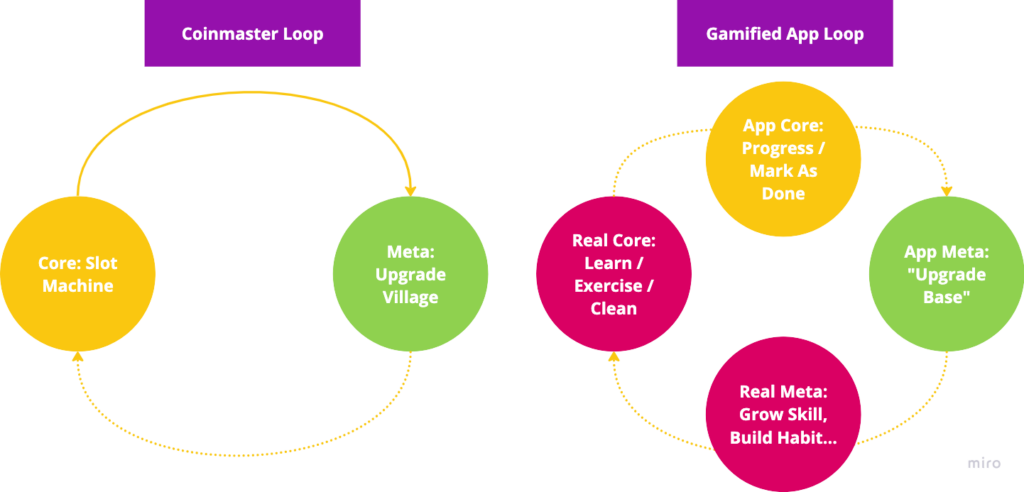
Before we get started on the benefits of gamification, we need to make one thing clear. Gamification is not making an app into a game. While certain apps like Habitica, a habit-building app with an RPG metaphor, do lean into the gaming aesthetic, it is not the only way.
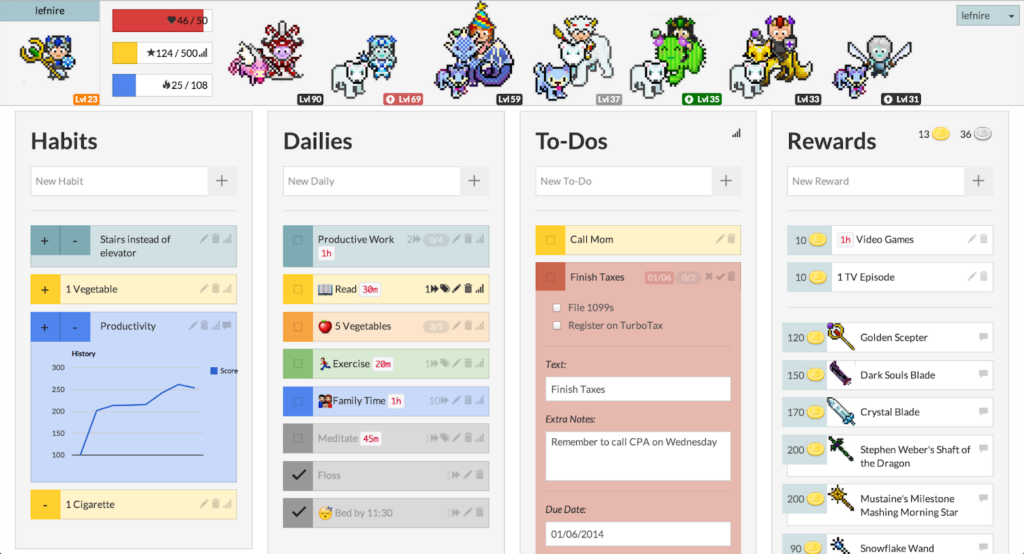
Gamification is about using the core principles behind games — progression, rewards, feedback, goal setting… etc. Gamified apps can be as far away from looking like a game as you want.
Benefits of Gamification
To summarize the benefits of gamification is simple: It will make your app more sticky.
When it comes to gaming, one can easily play five different match-3 games, but it’s very unlikely that someone would track the same run using three different running apps.

Giving the user a strong reason to choose your app and to stick with it becomes immensely important, and a gamified layer that elevates the user experience can be the deciding factor.
For apps in categories such as habit-building, productivity, etc., gamification can make the difference when it comes to offering additional motivation and rewards in exchange for increased engagement.
For example, in Forest, a pomodoro app (pomodoro is a work technique that alternates between 25 minutes of focused work and a five-minute break), each successful cycle is visualized as a tree that gets planted and grown.
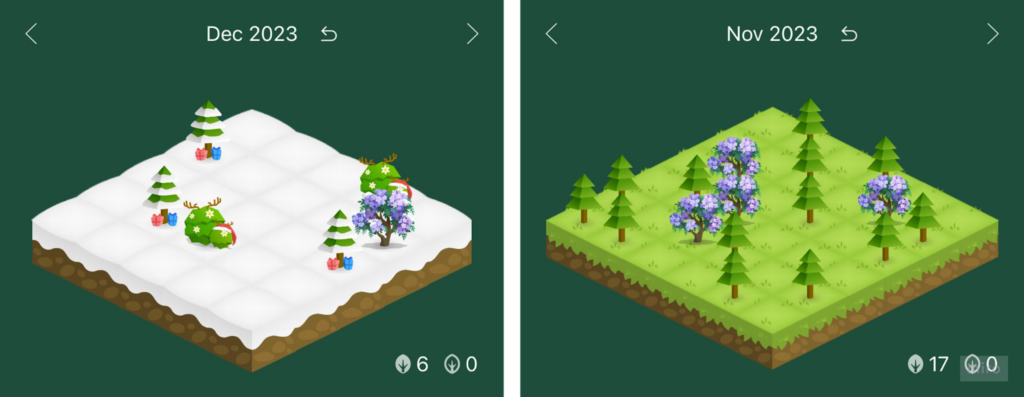
The app helps bridge a lack of motivation to work by offering something extra for the user’s effort. That effort is then visualized through a metaphor (a forest that grows more lush) that allows the user to see their growth due to a real-world, measurable activity.
Do note that some types of activities are more easily gamified than others. Let’s compare the following:
- A running app with the ability to track and display the user’s route and stats. The user experiences both the progress in the app and their real-world exhilaration from exercising, as well as improvements in their running skill.
- A yoga app where the user has to manually mark their exercise as done. They feel the satisfaction of completing the exercise, but having to self-report means there is a disconnect between the user’s experience and the app.
That’s not to say you cannot gamify the yoga app, just that there needs to be consideration for how the user interfaces with it.
Besides the activity type, one can even gamify the same activity in different ways by hitting different motivations. Let’s illustrate that with the help of two running apps: On one side of the spectrum, we have a “serious” app like Strava; on the other is an immersive narrative experience such as Zombies, Run!
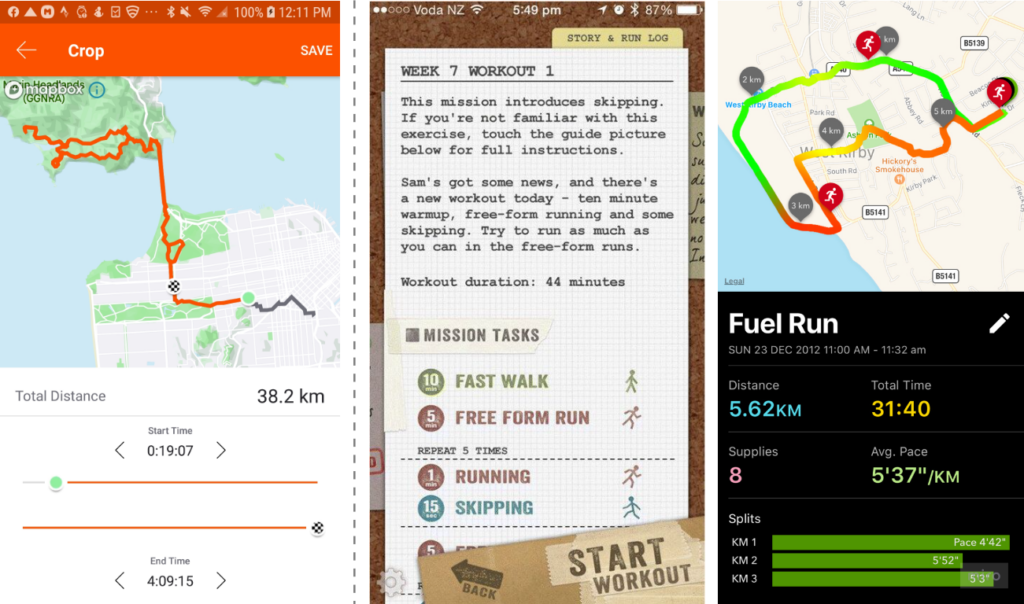
In Strava, the focus is set on a clean, straightforward, and social experience. The user sees where exactly they ran, linking their effort to a physical, familiar space. Importantly, users can share their efforts with their friends, see what everyone else is doing, communicate if they travel, compete in challenges, and more. While the app relies on some gamification, it doesn’t bring in extra progression layers,though it definitely could.
On the other hand, Zombies, Run uses a zombie apocalypse narrative in a story the user unlocks by tracking runs. As the user moves on their route, the app unlocks portions of the story with distance milestones and rewards resources to expand their base.
Both these apps work differently with motivation and will attract different audiences — Strava focuses on users who enjoy social competition, while Zombies, Run is aimed at users who enjoy narrative and individual growth.
Gamification Genres
Before we go further into our deep dive, we will set some context on the current market for gamified apps and explore the key trends. Gamification is a broad term that can encompass various mechanics, and there is no genre taxonomy for “gamified app.”
The two main lenses we used when selecting app genres to focus on were whether the apps gamified some sort of progression or improvement and whether they aimed to support the user’s goal of self-actualization, or the desire to be all that you can be (the top of Maslow’s pyramid of needs).
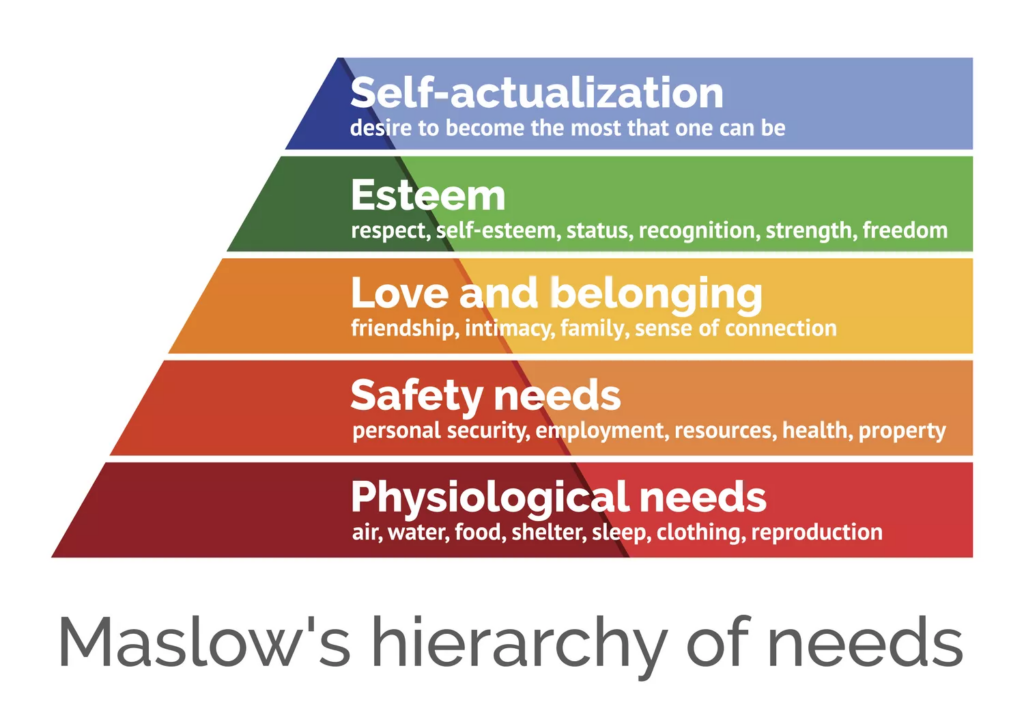
Key Performance Indicators Overview
Using the two lenses, we have selected five app subgenres in data.ai that are most likely to contain gamified apps.
| Order | Subgenre | data.ai definition |
| 1 | Fitness Program | Apps that offer workout programs for weight management and muscle building. |
| 2 | Language Learning | Apps that help users learn foreign languages, including helping users pass language tests. |
| 3 | Musical Instruments | Apps that allow users to learn musical instruments or play virtual musical instruments on their mobile devices. |
| 4 | Weight Loss & Calorie Tracker | Apps that assess calories, nutritional values, or food intake to help with a healthy and balanced diet. |
| 5 | Mental Health | Apps that improve users’ mental health through ways such as music therapy, meditation, mood tracker, etc., so the users can relax, relieve stress, or sleep well. |
Overall, this cohort of apps saw 2.07B downloads in 2023, collectively earning $1.87B in revenue.
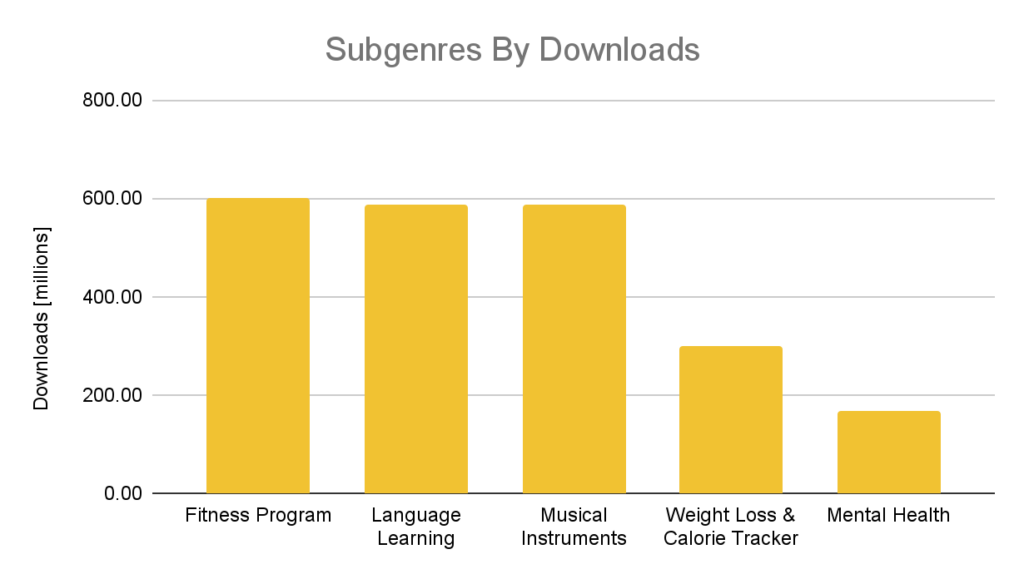
As we can see, Fitness Program, Language Learning, and Musical Instruments are the big three in terms of downloads, with a sharp drop for Weight Loss and Mental Health.

Revenue-wise, Language Learning leads the pack, followed by Fitness Program, Weight Loss, Mental Health, and Musical Instruments.
Some key observations:
- Duolingo, a gamified app, dominates Language Learning, making up ~50% of the segment’s revenue.
- Weight Loss apps are more revenue-efficient, making more money on fewer downloads.
- On the surface, Musical Instruments look like the least revenue-efficient category. However, many of the apps are ad-monetized.
Now that we've established the broad landscape of gamified apps and presented the related data, let's zoom in on the particular trends.
Trend 1: Fitness Apps Monetize the Best

As a whole, Fitness Program downloads in 2023 were 602M , up +2% year-over-year, while taking in a combined revenue of $553.3M, a rise of +13.5% YoY.

We’ve also seen a huge increase in different types of fitness apps that fit whatever users feel like doing — dancing, yoga, pilates, HIIT, or celebrity fitness, it’s all available. These apps come with light gamification elements, such as progression and social competition, which enhance engagement and lead to improved outcomes. Paired with the immediate and tangible results from physical exercise, it’s understandable why these apps have seen such steady growth.
Trend 2: Mental Health Stands Out For Its User Value

Mental Health app downloads in 2023 were 167M, down by -4.8% YoY. Revenue went up by 6.8% YoY, reaching a total of $323M.
Among the top downloads are familiar meditation apps like Calm or Headspace, alongside apps like Sleep Sounds Tracker, which monitors sleep patterns to improve sleep quality.
While the smallest segment in size of downloads, Mental Health holds consistently the strongest revenue per download. In 2023, it had an RPD of $1.94, over 30% more than weight loss apps in second place, indicating that users find great value in the apps.
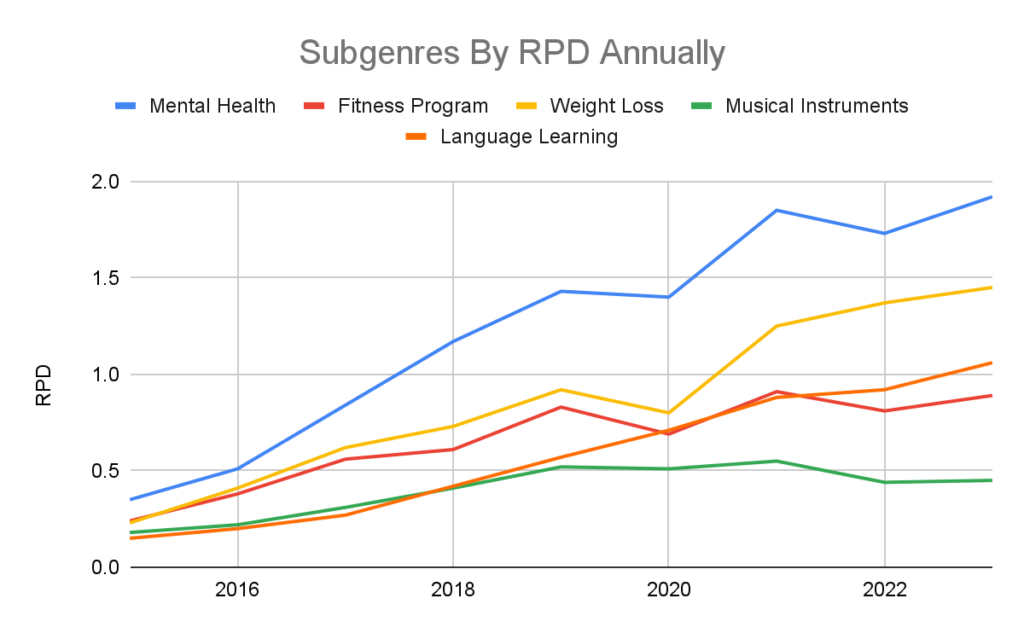
Compared to Fitness, Mental Health faces a few development challenges that may explain the segment’s slower growth:
- Mental health content requires more specialized expertise, which may involve therapy or counseling skills.
- The stigma surrounding mental health makes it more challenging to attract users and generate revenue.
- These apps often involve sensitive user data and may face stricter regulatory and privacy requirements, which can increase development costs and complexity.
Trend 3: Innovative Approaches to Subscriptions
The increased competition in self-help apps has resulted in developers taking new approaches to lure and keep their customers. Some innovative approaches include:
- Joggo lets the user earn the subscription back for running a certain number of miles.
- Balance offers the first year for free.
- Breeze: Habit tracker lets the users pick the price for a week’s trial.
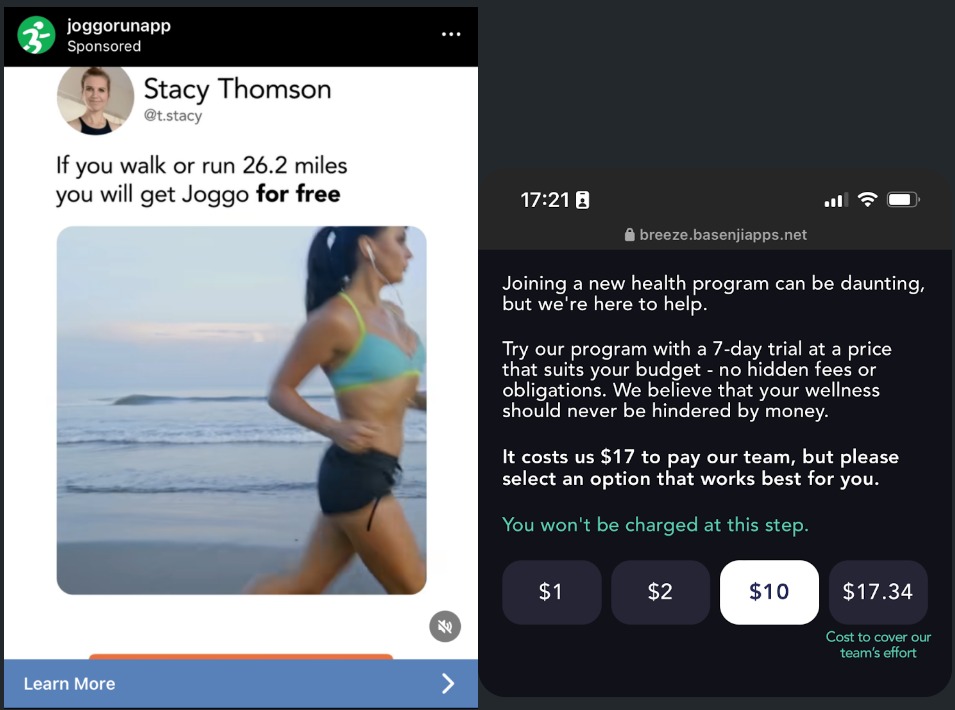
Conclusion
While Fitness Program apps are currently the leader in gamified apps, Mental Health apps hold significant promise for several reasons. First, there is a growing awareness and de-stigmatization of mental health issues.
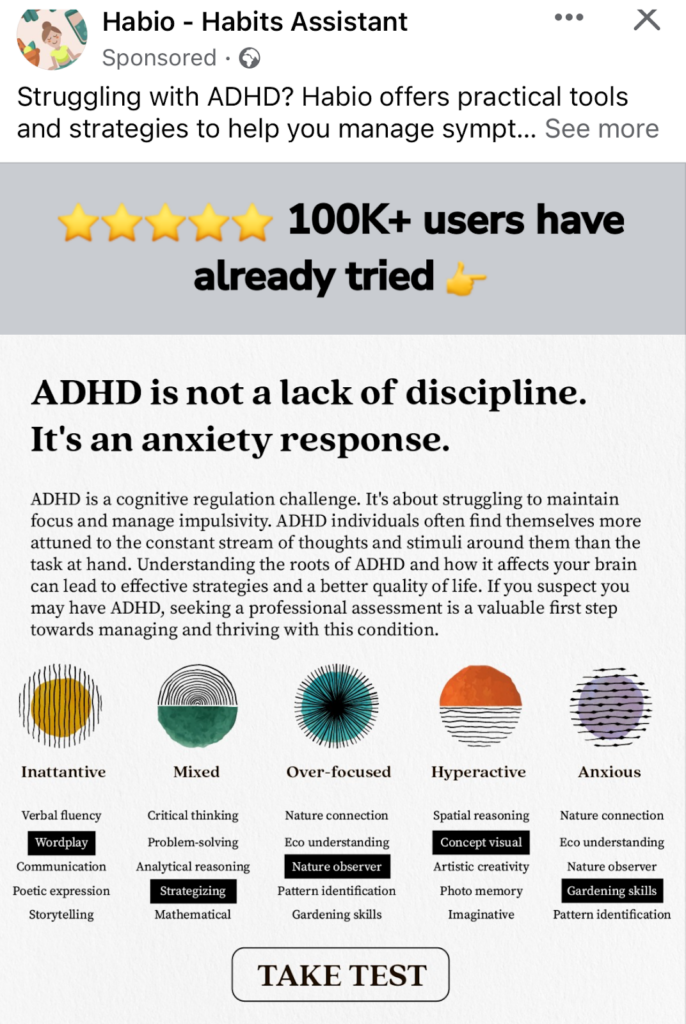
The importance of mental health is rapidly gaining acceptance across the globe. New generations are more willing to talk about trauma, appreciate neurodiversity, and put thought and resources into improving their mental state.
Second, the global demand for mental health support and self-care tools is on the rise. However, there is a lack of therapeutic resources to match the rising demand, especially in the post-pandemic world. One of the ways to meet one’s self-care needs is via technology, and we can see in the chart below that Google searches for “mental health app” have been rising steadily.
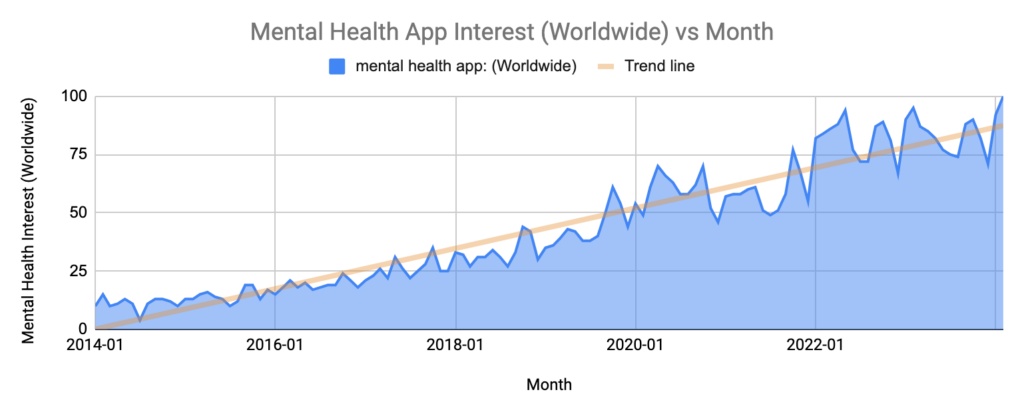
Lastly, the long-term benefits of improving users' mental health and well-being extend far beyond financial gains, contributing to a healthier and more resilient society. Therefore, a closer examination of mental health and self-care apps opens a promising landscape ripe for growth and positive impact.
Gamification Case Studies
As seen above, there are various genres of gamified apps, but we are focusing on the growing mental health category, and specifically on habit-building apps for the following reasons:
- Habit-building is a growing subgenre within mental health apps. While not yet reflected as a category in data.ai, we see a huge increase of these apps in advertisements on Facebook and Instagram, among others.
- These apps require the user to self-report completed tasks. Opening a habit app and reporting every single small task you’ve done can feel tedious and unsatisfying. This is a perfect opportunity to gamify that interaction to improve that experience.
- There is significant opportunity to create personalized content that can help users better achieve their goals. Imagine taking the dynamic balancing and personalized offer systems from games and using it to tailor a habit-building program instead. With the power of AI, this can be even more supercharged.
The Habit-Building Loop
Before going into the app case studies, we first need to understand the behavioral psychological principles behind habit-building loops.

Here's how these loops typically work:
- Trigger (Cue): This is the signal that prompts the user to take action. In the context of mobile apps, triggers can be time-based (morning alarm), location-based (arriving at the gym), or event-based (receiving a notification).
- Action (Routine): Once the trigger is activated, the user performs the desired action or routine. This is the behavior or habit the app is designed to encourage: Exercising, meditating, journaling, or any other activity the user wants to make a habit.
- Reward (Reinforcement): After completing the action, the user receives a reward or reinforcement. This is a positive consequence that encourages the user to repeat the behavior. Rewards can be intrinsic (a sense of accomplishment) or extrinsic (earning points, badges, or social recognition).
- Feedback (Tracking and Measurement): Feedback is an essential component of habit-building loops. Users need to see their progress, which reinforces the habit. The app can provide data, statistics, charts, or the narrative metaphor that communicates how well the user is sticking to their routine.

Humans are habit-based creatures, and in a natural environment, our habits can sometimes become unhealthy. To replace them with healthier ones, habit-building apps use the habit loop to reinforce healthier habits and magnify the rewards with extrinsic rewards like in-app progression.
As you can see, the whole Trigger-Routine-Reward-Feedback mechanism very much mirrors the same psychological principles behind games, and there are many systems that can be taken from games that would apply toward habit-building apps.
With that context set, let’s take a look at our three apps for our deep dive: Me+ Daily Routine Planner, Daylio, and Finch: Self Care Pet.

Me+, Daylio, and Finch Introduction
We chose these three apps because each one of them can teach us something different. While all three focus on habit-building through the mechanic of completing daily tasks that contribute to healthier habits over time, they have several differences in execution.
Me+ Daily Routine Planner and Daylio are more straightforward, contain few gamification features and reward the user’s persistence simply by tracking their progression.
Finch: Self Care Pet stands on the opposite part of the spectrum: It’s a fully gamified app that uses the metaphor of a pet bird for progression. The user’s core actions translate into its well-being and growth. The app combines many features we know from games- energy, soft currency, quests, equipment, and more.
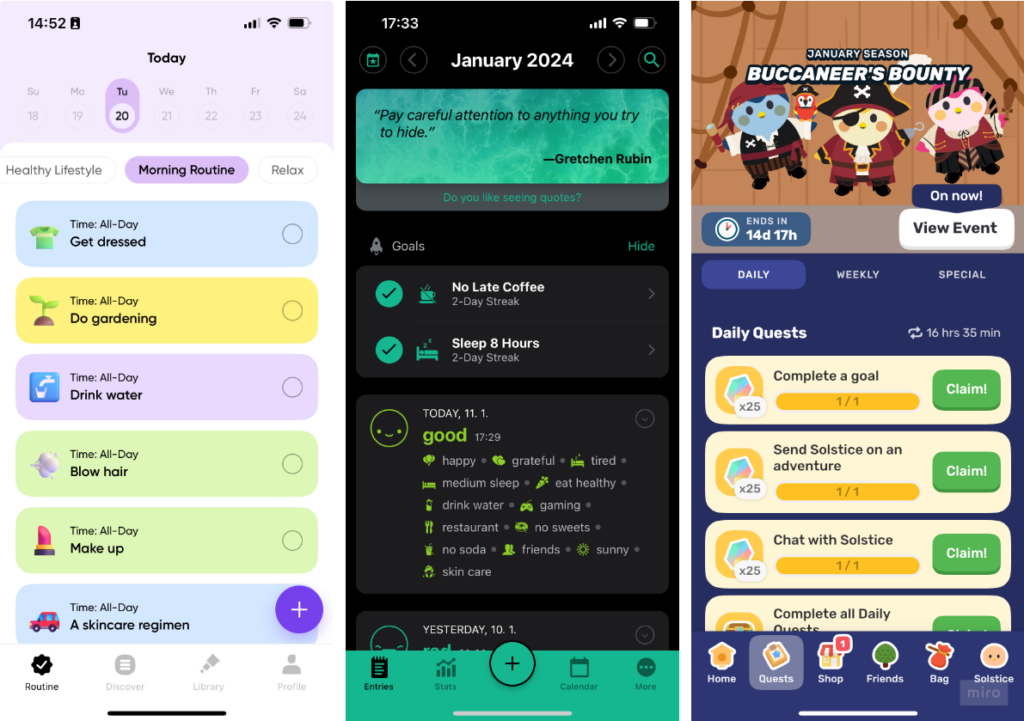
KPIs Overview
The table below summarizes some of the key KPIs for the apps for 2023.
| Downloads | Revenue | Avg. MAU | RPD | D1 | D7 | D30 | |
| Me+ | 16.0M | $11.7M | 4.09M | $0.94 | 30.91% | 12.10% | 7.31% |
| Finch | 6.23M | $5.88M | 4.76M | $0.86 | 58.42% | 29.15% | 18.24% |
| Daylio | 2.01M | $1.92M | 2.07M | $0.35 | 65.55% | 45.75% | 37.69% |
Each of these three apps is an outlier from a different KPIs perspective.
- Me+ has recently seen skyrocketing downloads and revenue.
- Finch has had the most active users due to good downloads and retention.
- Daylio has extremely good retention, but struggles to acquire new users.
Me+ by Enerjoy was released for iOS in January 2022, and spent a year in soft launch. The Android version was released in August 2023, and that, combined with scaled-up user acquisition campaigns, meant that within the last six months alone, Me+ amassed 16M new users, juicing up its revenue. Whether this is a return-on-investment-positive UA spend or an attempt to capture the habit-building market remains to be seen.


Finch’s strong gamified hook has been consistently bringing in the most active users (~5M MAUs) among the three, only recently being dethroned by Me+ due to its downloads surge.

Daylio (by Habitics) manages to retain users long-term to a degree none of the other apps comes close to. Its Day 30 retention stays consistently around 40%, compared to Finch’s 22% and a very low 3.2% for Me+.

We also want to understand what each app does well and where it can improve so we can combine these lessons into a manual for a gamified self-help super app.
Shared Insights
App Overview
All three apps offer similar feature sets. Some techniques, like journaling or mood tracking, are generally acknowledged as good practice in habit-building. Others, like libraries with workout or meditation content, have become tropes of the competition in the self-care app world.
Me+ and Daylio bear more similarities — they rely on science or the aforementioned tropes — while Finch takes a more gamified angle, but eventually, the feature sets do not differ massively.
We will start by summarizing the shared features and pondering their usefulness. Then we’ll zoom in on each app and discuss the differences concerning each app’s success within a different set of KPIs.
First Impressions
Hooking the user within the first few seconds is just as important in habit-building apps as everywhere else; developers need to sell the app's value before the user closes it.
The typical steps here involve referencing the science behind the app and personalizing the experience, often in the form of a survey that lets the user feel like their personal struggles have an impact. It’s also very common to emphasize that the habit change plan is customized for the user. The end of the onboarding process typically ends with a week-long trial subscription, and this is true for all three apps we looked at.
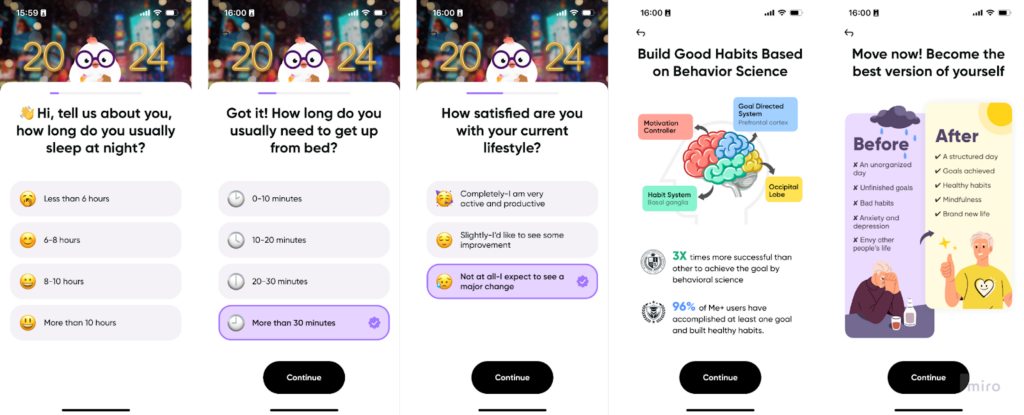
As you can see above, Me+ puts all of these tropes into action, with a survey followed by an illustration of the science behind it. Daylio, seen below, takes a slightly different approach, explaining how noticing patterns relates to building better habits. It’s informative, but it lacks a personal approach.
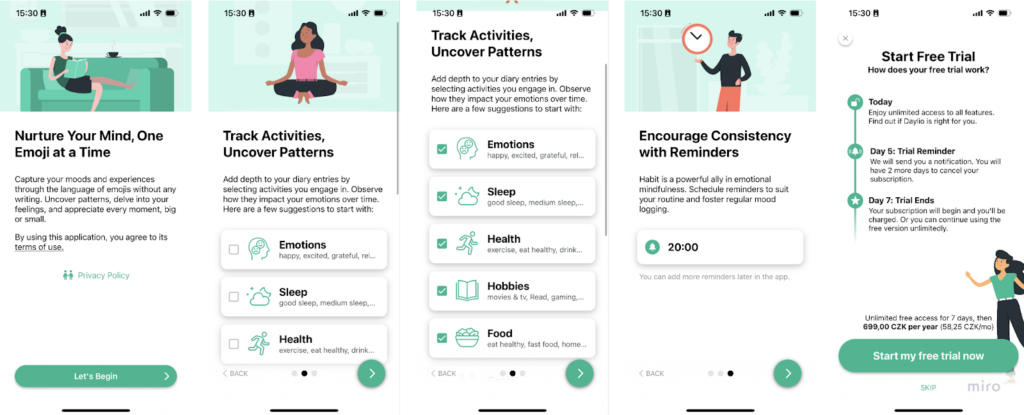
With its pet-care metaphor, the onboarding for Finch is slightly different. It lets users select and name a companion, then commit to a set of simple tasks (like “Survive the day”). There’s an effort to build a personal link in the onboarding that pays off — the Day 1 retention rate reaches almost 60%, which is a lot, even for the subscription-based apps (and definitely a lot compared to F2P games).
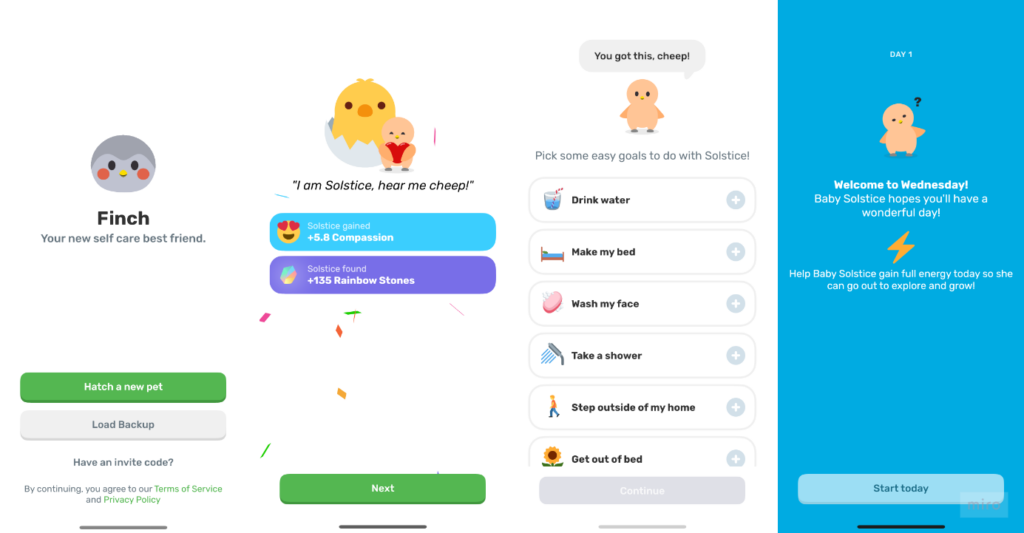
But the D1 retention leader is Daylio, currently around 65%. Here, the cause is likely the complete lack of UA. Users who discover the app organically will be serious about this self-change business.

Some apps also emphasize the commitment of the user by letting them confirm or sign a sort of contract with the app (or rather, with themselves). Within our cohort of apps, only Me+ uses this mechanic, but it’s something we’ve also seen in other apps like Fabulous. While it’s a great idea to formalize the player’s commitment as a contract, it’s often a one-time thing without any follow-up, and can feel more like all hat, no cattle.
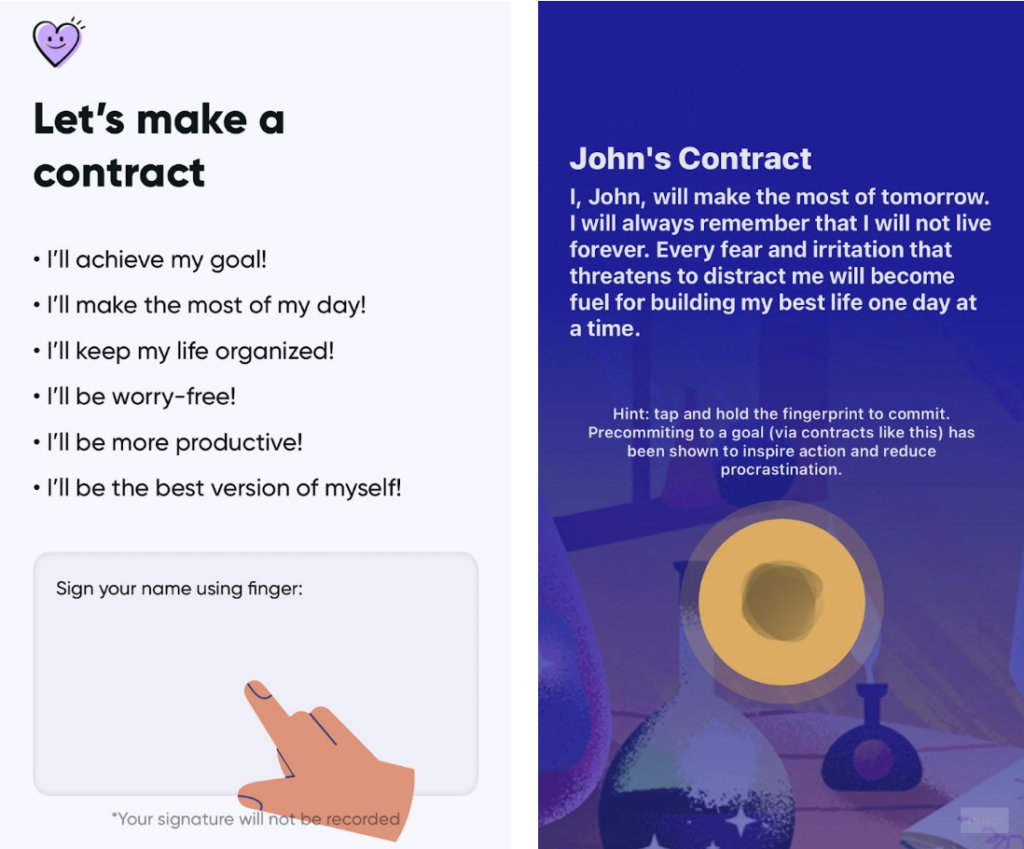
Tasks
The backbone feature in all of these apps is the ability to select or set up tasks in the form of a to-do list for each day. The user is encouraged to check in several times a day to manage the task list, putting a lot of emphasis on simplicity of use.
All three apps do a good job at this, and it’s fairly intuitive to set up the tasks and start the core engagement.
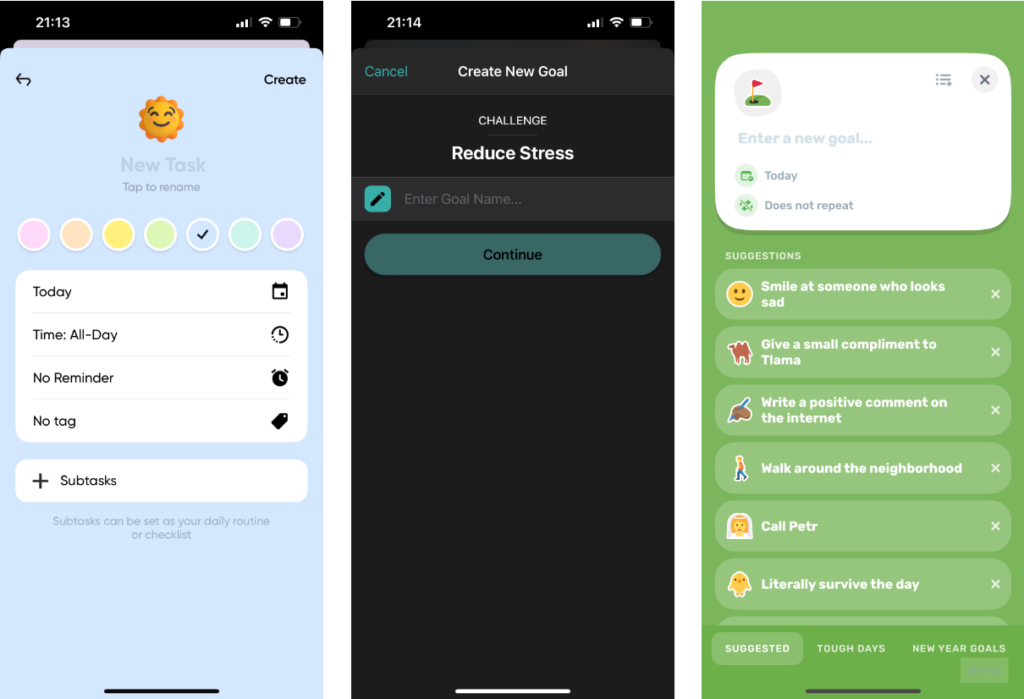
A nice touch from Finch is a word recognition function that automatically adds corresponding icons to the user’s custom tasks.These icons not only add readability for the user, it also allows the app to sort and include these tasks as part of its analysis and output to the user.

Besides individual tasks, all apps also have the ability to group these tasks into a set.
Me+ offers “Routines,” which are predefined sets of tasks. These are listed in different categories, ranging from purpose (Morning Routine) to seasonal (Fall Routine), and some are community or TikTok-based.
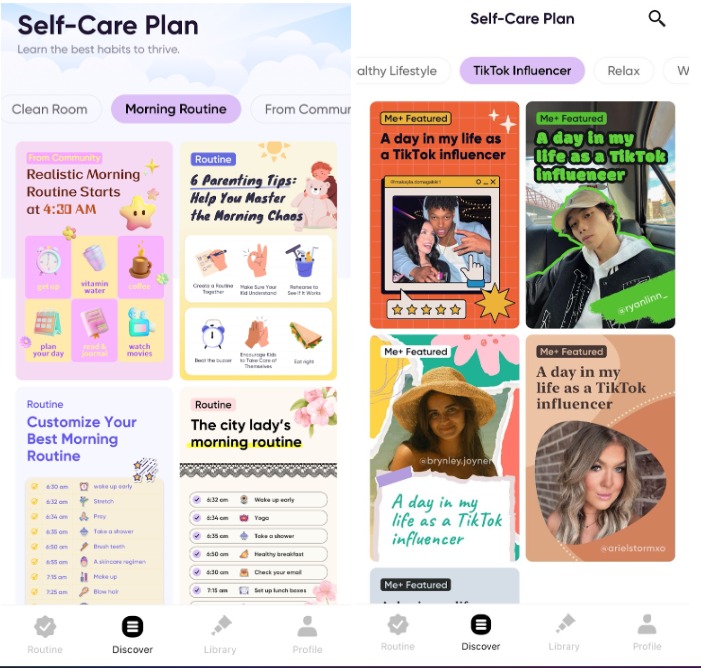
Similarly, Daylio implements Goals (individual tasks) and Challenges (a set of tasks). The level of adjustability is similar, though the tasks are better grouped, hinting to the user that it’s desirable to match the Challenges to their goals right from the start. This makes the onboarding journey easier and the user easily sees what they could focus on.
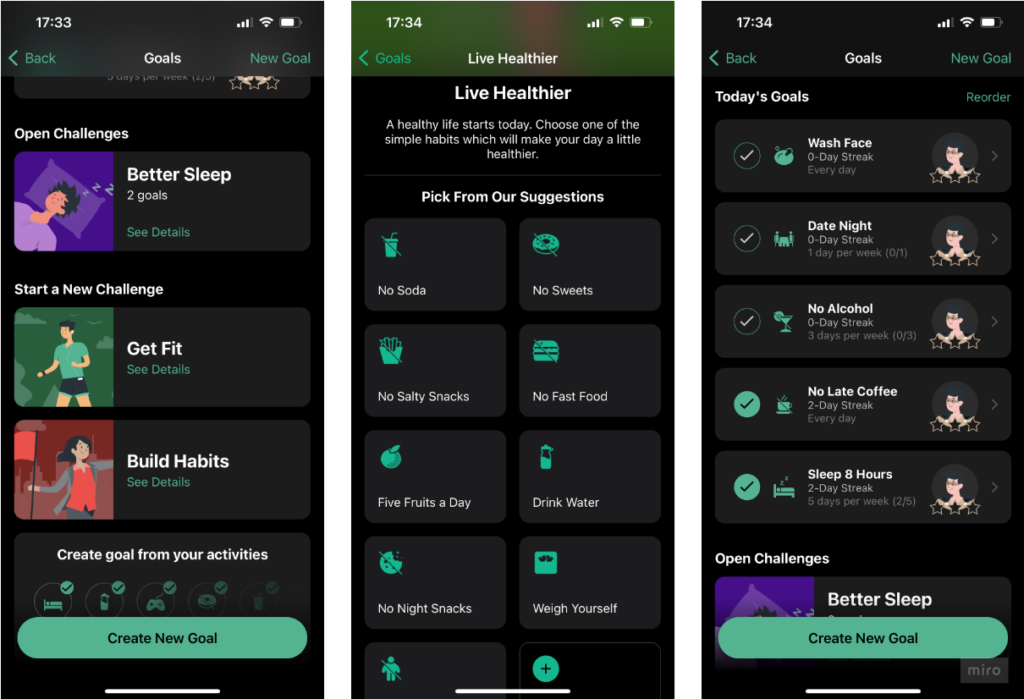
Like the others, Finch also offers grouped tasks called Goals, but they feel rather light and read as mere suggestions, compared to the Challenges that are meaningfully and cohesively organized in Daylio. The mechanics around tasks and task completion are also interwoven into the core loop in a slightly different way than Me+ and Daylio, and we’ll cover that in detail later on.

Progression
If all that these apps provided was a to-do list, then users might as well use tools like Google Tasks, Apple Reminders, or Microsoft To Do. How they differ is by tracking progression, which serve as measurable and tangible evidence of a user’s achievement in habit-building.
Each app uses a different metaphor for progression: Me+ sticks to a simple calendar, Daylio provides an impressively extensive range of statistics, and progression in Finch takes the form of completed quests and leveling up the pet.
Me+ puts the least thought into making their user feel good long-term. Each day in a calendar is marked with a color and icon signifying the “day’s quality” aka task completion rate.
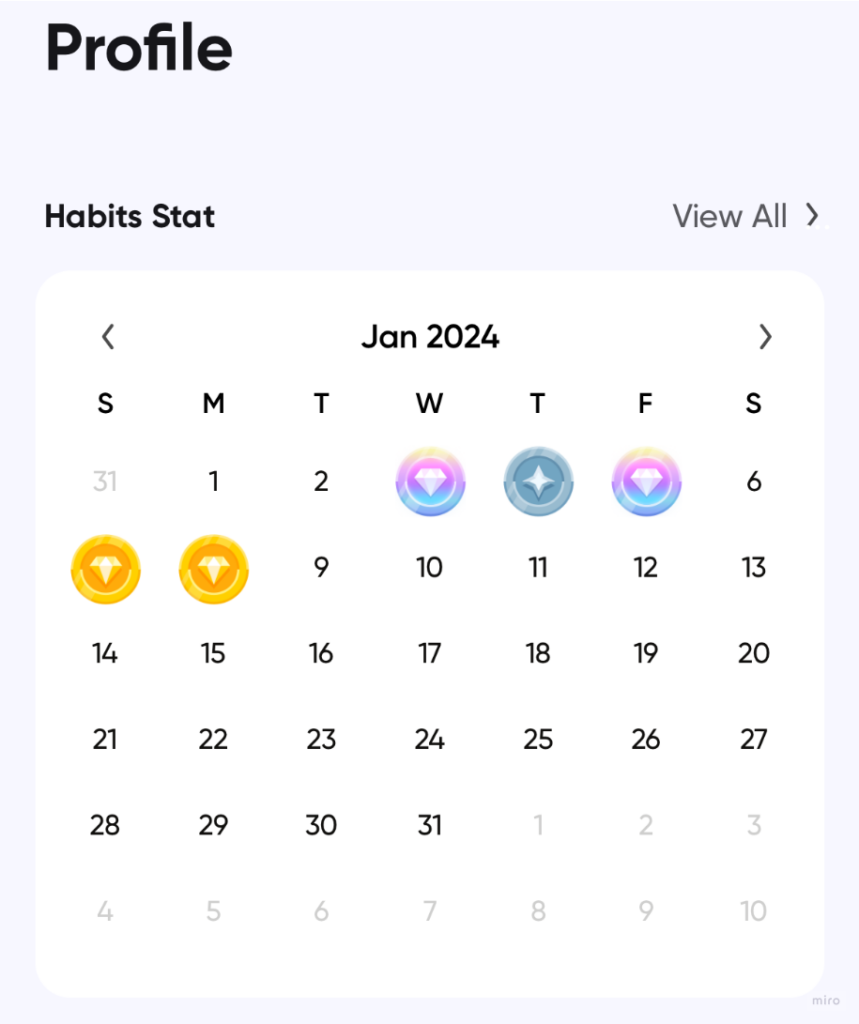
The icons are hard to read due to non-standardized use of color language (can you determine which day has the highest quality above?) What’s worse, a day’s quality is only determined by task completion ratio, so the more you challenge yourself by having more tasks listed, the harder it is to get the best quality day. It feels demotivating, underdesigned, and at odds with the purpose of a habit-building app in the first place.
Daylio, on the other hand, tracks the progress and streak on each task, really pushing the user toward repetitive engagement. It does this by rewarding repeating tasks during the week, and accumulating completions will level up the task (see screenshot below).
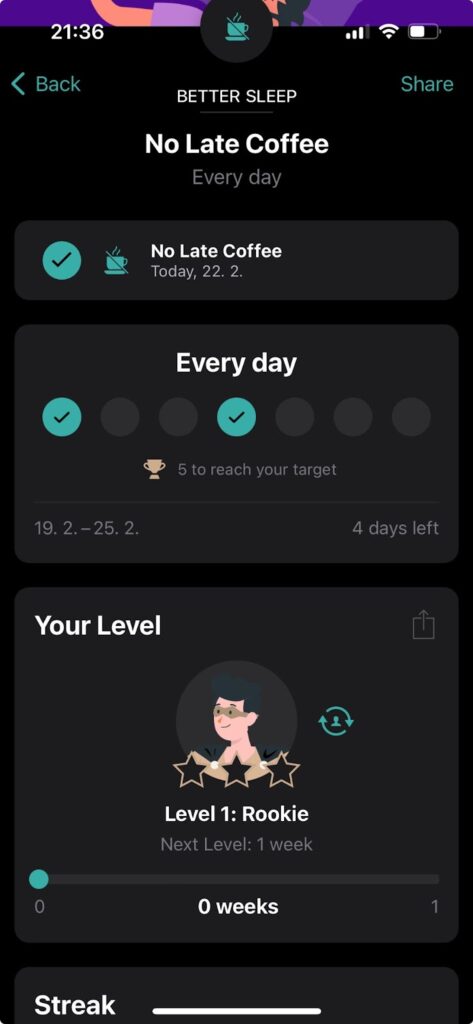
This really harnesses the power of positive reinforcement and is a feature unique to Daylio. The downside is that it isn't visible unless the user earns a tier of progression.
Daylio also lets the user summarize each day by selecting how they felt or what they achieved regarding mood, sleep quality, health, eating habits, and more. The user’s daily mood is tracked over time, and is a visual indicator of how well they are doing toward their habitual changes.
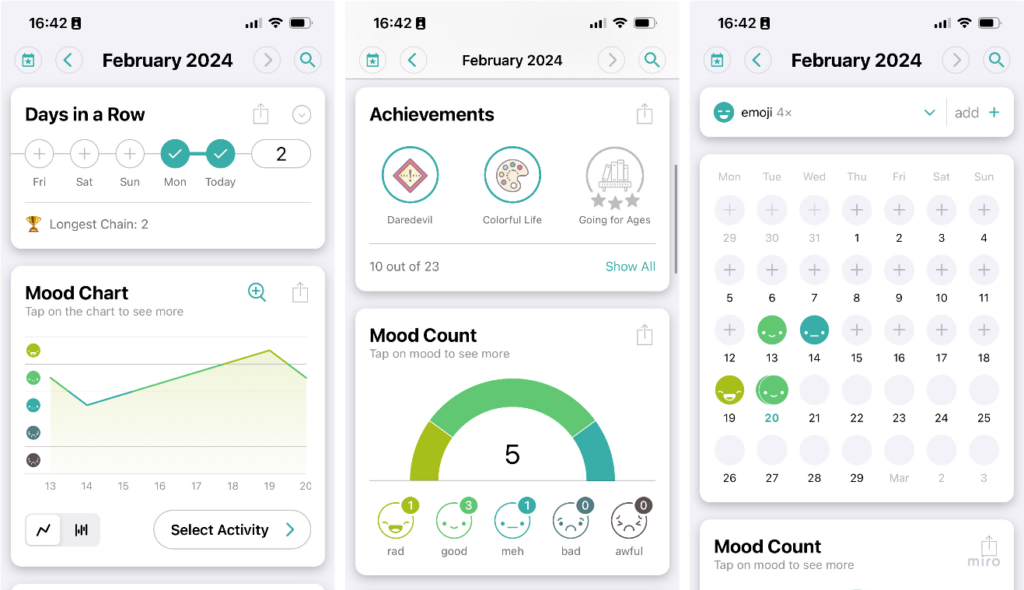
Summarizing the day by the mood rather than by the amount of completed tasks (like in Me+) changes the paradigm from the user feeling down because they didn’t manage to complete their to-do list, to a more holistic reflection of their habit-building journey.
Finch, true to its gamified nature, entirely steps away from statistics and takes a gaming approach. Longer-term progress is communicated through the growth of the pet, but for day-to-day engagement, it presents daily, weekly, and monthly quests that ensure a repetitive interaction.
Quest systems are a gaming trope, but we don’t see it as often in apps yet, which is a shame, as they can be powerful motivators and engagement drivers. However, implementing a quest system is not enough. Users need meaningful rewards to engage, and in Finch, these are Rainbow Stones that can be spent in the store for customization.
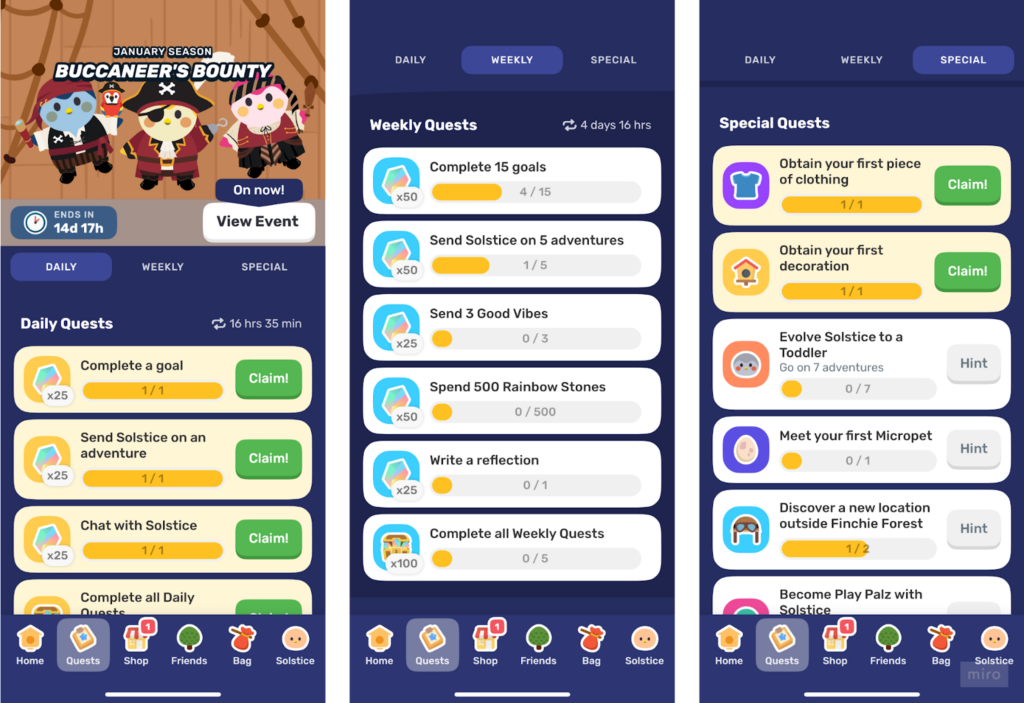
Mood Tracking
It is common to use techniques to bring attention to the user’s state of mind and make them realize how they feel. The two main techniques that apps often use are Mood Tracking and Journaling.
- Mood Tracking is a great tool that leads to an improved ability to connect the dots between one’s behavior and mood levels, which can lead to a desired, persistent change.
- Journaling can help process emotions, discover emotional triggers, and gain more self-awareness via deep reflection.
These two features often go — and should go — hand in hand. The benefit of technology lies in the ability to collect long-term data long, compare them against the tasks users complete, and derive learnings to communicate to the user.
Based on our analysis, this is one of the areas that could use innovation.
In this sense, Me+ is doing the least. It recently added a mood tracking option but the user isn’t prompted to use it. It also offers journaling with a series of topics and leading questions, which feels a tad too heavy-handed. It showers the user with questions that are well intended but assume a very high level of self-reflection, instead of guiding the user through the process of learning how to ask the right questions.

In Finch, the app checks in with the user about their mood several times a day, but without a real actionable follow-up. Journaling is hidden in the menu as an extra option to reflect, and the app will sometimes use the pet to prompt the user to give features such as journaling a try.
Out of all the apps, it’s Daylio's version that is the most robust: The evaluation of each day is seamlessly woven into the app flow and the user is guided by letting them choose from a variety of options. By letting the user not just summarize their mood (as in the other apps) but having them dive into details, they’re able to bring certain patterns to the surface. Journaling is also available in each day’s summary if the user feels like expanding on the details.

And there’s one extra and useful feature: On iOS, the app links to the native Health app. Using data such as sleep hours or steps, it informs the user about the relationship between their health activities and mood, letting them draw conclusions from the patterns. A user can see that certain behavior one day impacts the following night’s sleep, which then impacts the mood on the next day, and so on. If there’s an improvement to make here, Daylio could do a better job communicating specific suggestions.
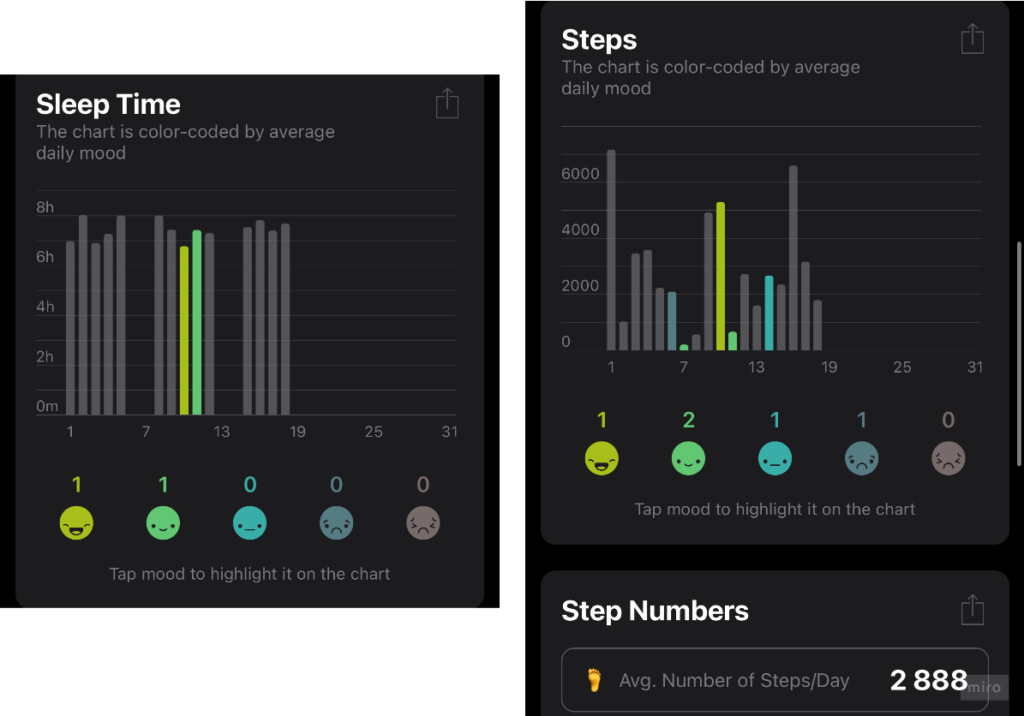
Supporting Features
Some apps come with a plethora of linked features that tie well with the main narrative of self-care. Typically, these involve guided meditation, exercise, or first aid (e.g. breathing exercises) — anything that can count as supportive to the user.
Both Me+ and Finch include Meditation, Exercise, and a Sound Library organized in a categorized inventory, while Daylio eschews these supporting features.
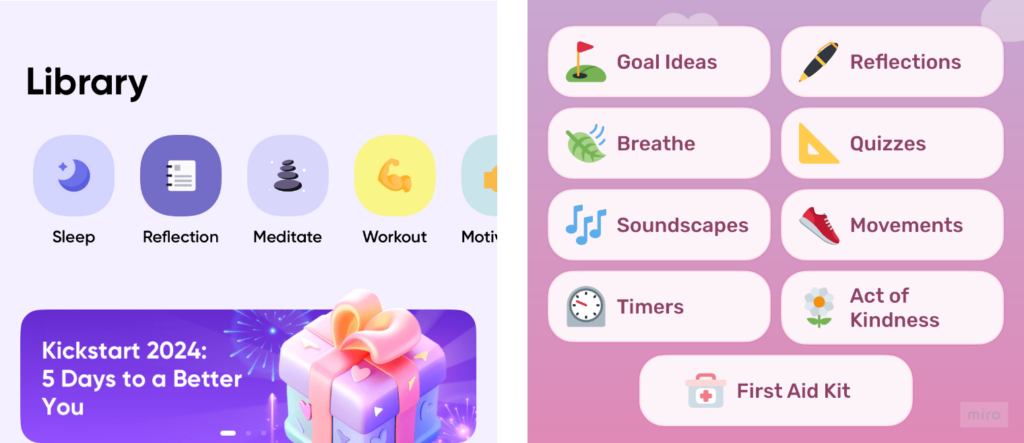
While it’s nice to have these additional features, we do want to point out that meaningfully linking the features together holds more value than their quantity — as seen in the example of the well-executed Mood Tracking and Journaling in Daylio.
Adding these additional features can be a functional monetization tool (Finch locks some of this content behind a subscription), and it’s helpful to find everything in one app, but for this content to feel really meaningful, the apps need to integrate them better. Otherwise, they’re dead weight, and users will look for external medication or exercise apps with a strong USP.
Business Model
All three apps use the Free-to-enter subscription model, in which anyone can use the app and its basic features, but some content will remain locked behind a premium subscription.

This is different from other types of apps with more elaborate content, like fitness apps that offer specific workout routines and exercise videos. Those apps typically offer a small taster (like Yoga Go), but to engage further, the user needs to subscribe.

While subscription models are effective for content-rich apps in categories like fitness, self-help apps could benefit from exploring F2P models with in-app purchases or microtransactions alongside the subscription.
Self-help apps have a disadvantage against fitness apps in that the user’s progress is harder to normalize and measure to create a one-size-fits-all solution. There's no obvious habit-building equivalent to specific programs in fitness apps, making the benefits of subscriptions less obvious and the users less likely to convert.
Making the app F2P and adding a gamified metagame opens up the funnel so more users can experience the benefits themselves. If they choose so, they can further enhance their experience with in-app purchases. As long as those IAPs fit the experience and core values of the app, and provide joy with the linked action, the user will benefit.
Having IAPs also means users who are reluctant to commit to a subscription have other lower-friction options to enhance their experience, adding to the developers’ earnings.
We would recommend creating IAPs with clear value that does not negatively impact the core loop. For example, unique cosmetics for the user’s avatar or pet, special supporting actions within social groups, personalization and so on. Just like Finch’s sponsorship program — mentioned next — represents the values of the company, there’s space for wholesome microtransactions.
On our list, Finch is the only app with a soft currency, but even then, there’s no option to directly purchase it, and the user earns it mainly for completing quests and other actions.
As a cool and thoughtful feature, Finch implements a way for the users to sponsor the subscription for those who can’t afford it, which feels wholesome and in line with the app’s primary intention to improve lives and its origin story (which we cover later).
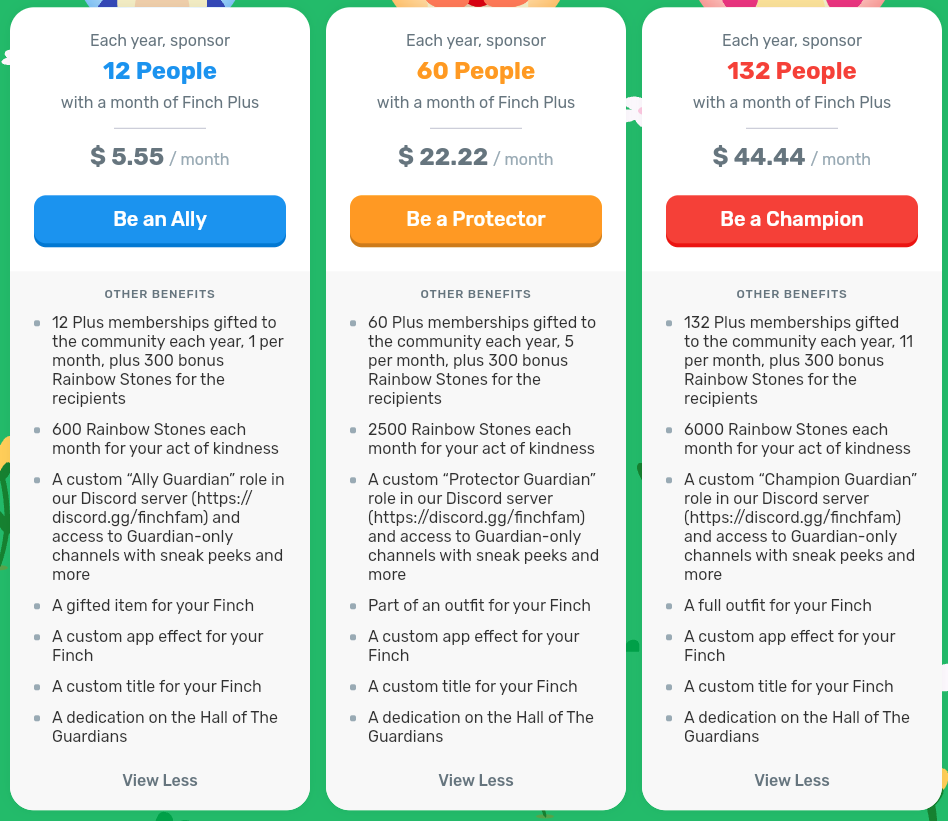
Now that we’ve covered the shared features, let’s go through each app’s USP.
Zooming In: Me+ Daily Routine Planner
Me+ is created by Israeli company Enerjoy, which also has other self-care apps, such as Sleep Sound Tracker and JustFit: Lazy Workout, in its portfolio.
Me+ could be seen as an MVP in the habit-building app space, and simplicity is both its greatest strength and weakness. It contains all the major features we described — and extra meat on the bone borrowed from the other apps by Enerjoy — but focuses very little on guiding the user through them.
At first glance, Me+ looks like a self-care super app that contains everything and the kitchen sink: habit-building, meditation, workout, and listening to soothing sounds.
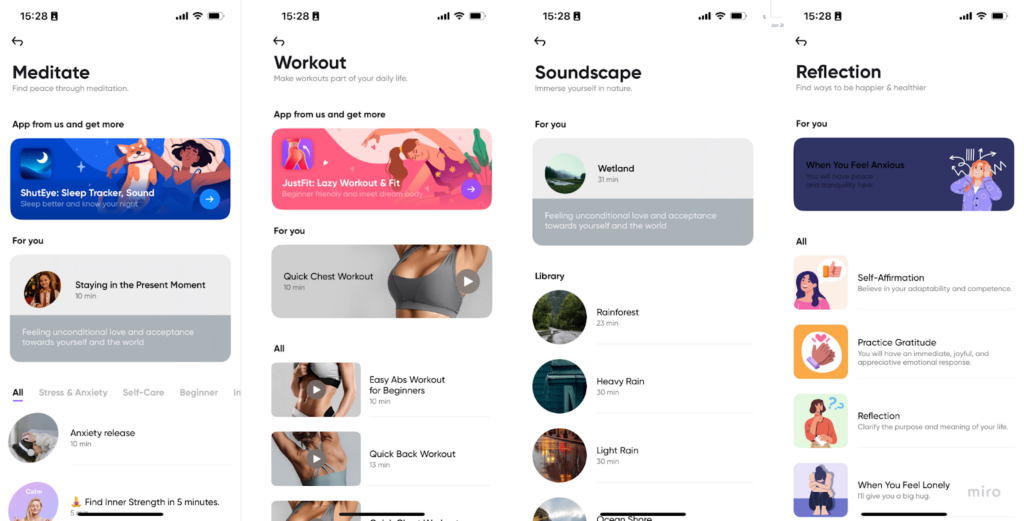
But as we get deeper, we see the cracks: The app lacks guiding flows, relies on the user trying the features out on their own initiative, and generally misses out on opportunities to help the user out.
The journal is a good example. Me+ leaves the user to fill up the blank page after a generic prompt, while Finch provides specific examples and asks one question at a time. It’s a subtle example, but one capturing the essence of a functional flow done with the user in mind.
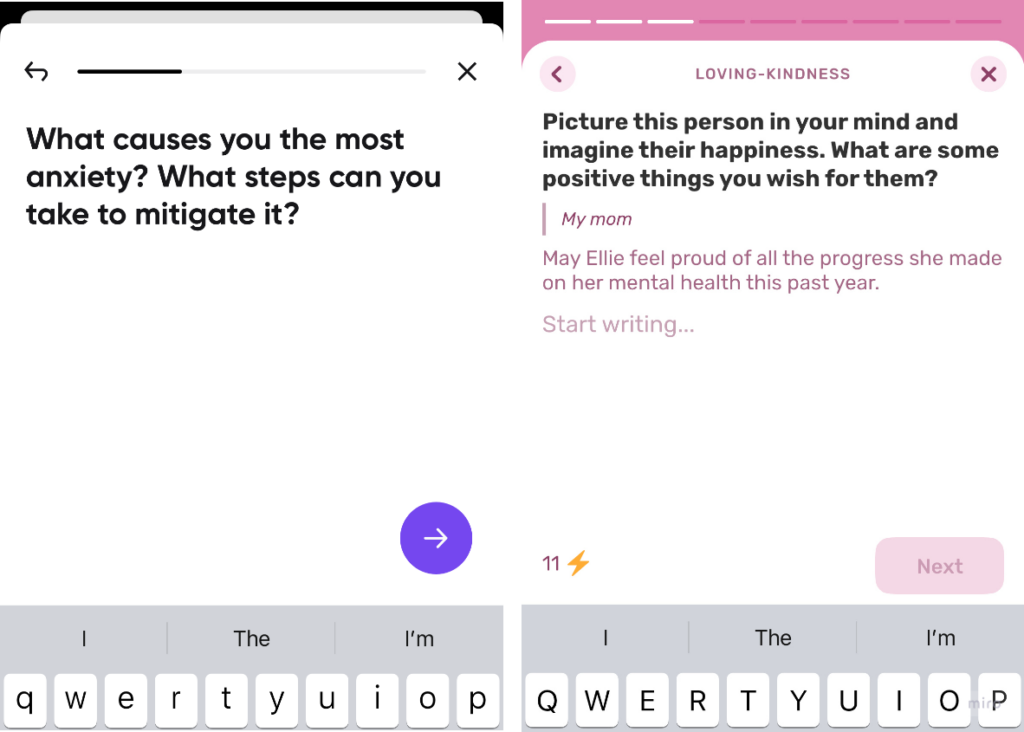
Me+ also has a weak progression metaphor, the key reason why anyone uses a habit-building app in the first place. Me+ settles for a calendar and a very light overview, but its biggest crime remains to be the concept of “Perfect days”. To achieve them, the user needs to complete all the tasks they set up, be that a few or many. What this does is punish users who strive to do more (and may fail at completing all tasks), and encourages sandbagging (it’s easy to have a one-task Perfect Day).
Conclusion & Key Takeaways
Me+ has achieved significant success in terms of revenue and downloads, indicating a high level of initial user interest and strong UA activity. However, it is struggling to retain users, and it’s not difficult to understand why people churn: It doesn’t put the effort into guiding the users and leaves them stranded. However, it still has done some things right.
Takeaway 1: Capturing Users’ Attention Needs to Happen Fast
Me+ understands that hooking the users comes with delivering a quick message. The first impressions of the app are:
- The promise of a personal approach communicated through the opening survey.
- The visually attractive routines linked to influencers.
- The library offering an unusual level of content for a habit-building app.
All that helps the app stand out.
Takeaway 2: Guide The User or Lose Them
The large variety of content Me+ offers in the Library comes from their other products. It essentially re-uses work and saves costs, while billing itself as a super app that has everything.
However, the library grossly fails to sell itself to the user. It exists in disconnection to the core loop, without any link back or forth, and the user is expected to explore it on their own.
The better way to do this would be to have tasks directly linkable to specific exercise routines or meditation from the Library, and vice versa. Below, we see this flow in Finch:
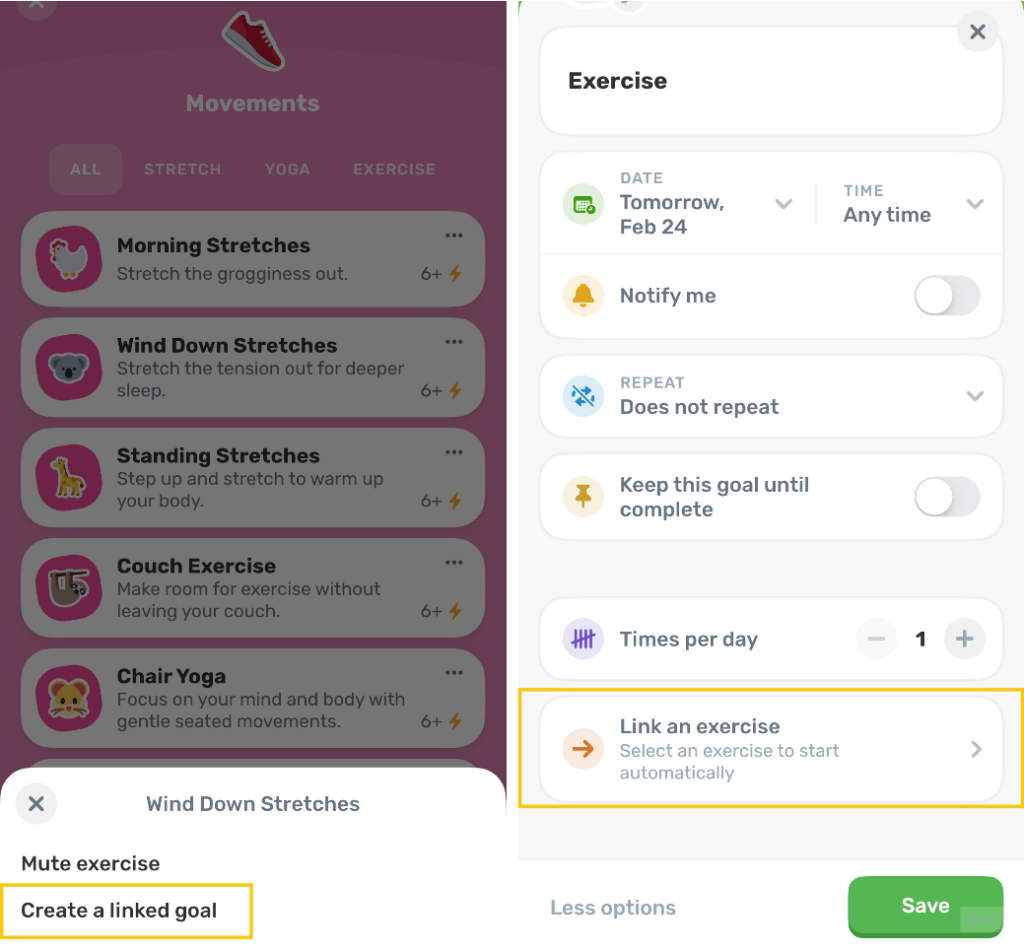
Creating a to-do list for the day and directly picking specific actions from the library could lead to higher task completion, given that committing to a specific exercise has more impact than a generic “do exercise” task.
Takeaway 3: Close the Loop and Reward the User
The task completion loop in Me+ misses the feedback part entirely because beyond checking off the task, the only recognition the user gets is the color mark in the calendar. There’s no bigger closure or satisfaction from completing each day, let alone a meaningful overview of the user’s progress. That results in a lack of perceived progression or achievement, which is essential for behavioral change.
In this sense, it has barely progressed beyond the original gamified habit-building “app”: the kids star chart (it’s arguably worse because you actually get rewards for collecting stars).
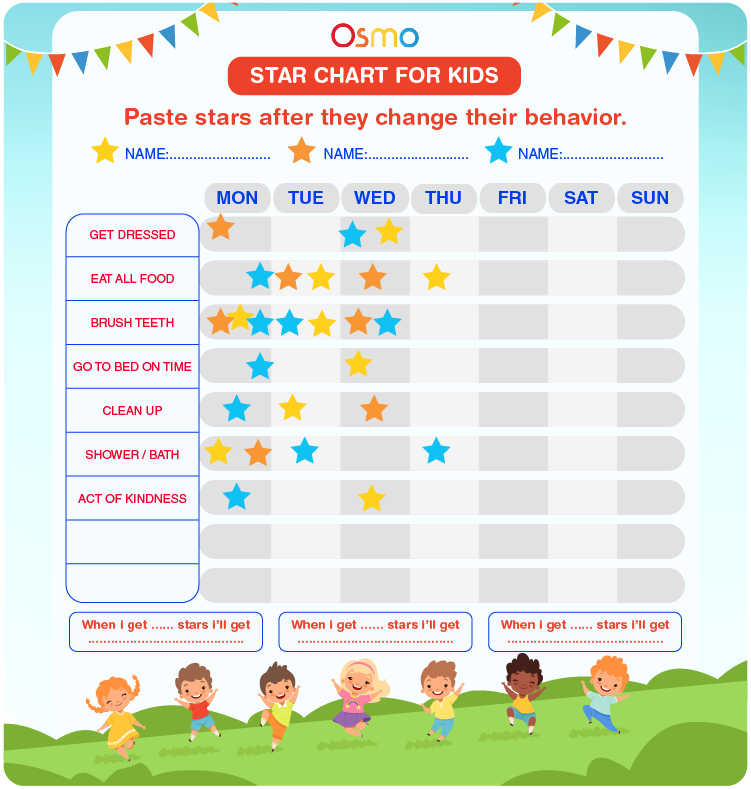
To be fair, it is not common to go very deep into progression in self-care apps. But there are ways to achieve closure and day completion, such as Daylio asking for the day's mood. There's also the whole universe of potential gamified progression mechanics that could reflect the user's effort and endurance beyond a mere calendar. In the end, it is about understanding the goals of the user and taking them into account every step of the way.
In light of the things that could be improved, we believe its success will be more temporary unless new features are implemented. Currently, we ascribe the high revenue and download numbers mainly to strong UA campaigns and the perceived first-impression simplicity that, in the long run, becomes more of a problem than a benefit.
Zooming In: Daylio
The developer of Daylio, Habitics, is a Slovak company that built several similar apps (similar to Enerjoy). However, Daylio is the only one still active and earning revenue. Since its launch in 2015, the app has earned $3.04M in revenue and 4.42M downloads. Certainly not impressive numbers, and in the ocean of sharks, Daylio is a small fish. However, we can take some important lessons from it.
Daylio is the antithesis of Me+. Where Me+ comes across as glowingly attractive but will leave you hungry soon, Daylio’s self-presentation may falter while its content feels rich and nutritious, if slightly bland.
Analyzing Daylio reveals solid user journeys, and while the feature set is limited compared to the majority of habit-building apps in the market, it does what it does admirably well and expands on the usual practices.
Let’s toss in a couple of examples:
- Many apps draw data from Apple Health, but Daylio interprets and looks for dependencies on that data better than other apps.
- It is also not unusual to ask the users for mood, but Daylio goes above and beyond by looking for patterns and presenting them to the user. The job of interpreting them is still on the user, but the app provides a solid base for that.
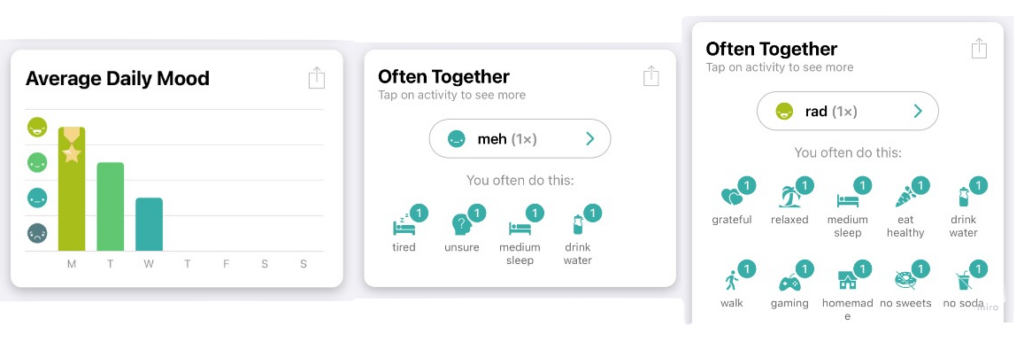
Another example of its thoroughness, Daylio integrates tiered achievements linked to many areas of the app. Achievements transform the onboarding phase from a mere tutorial into an engaging journey, encouraging users to explore various features and functionalities. Even though, just like in games, they will not speak to everyone, users who will find them engaging are the ones more likely to keep interacting with the app.
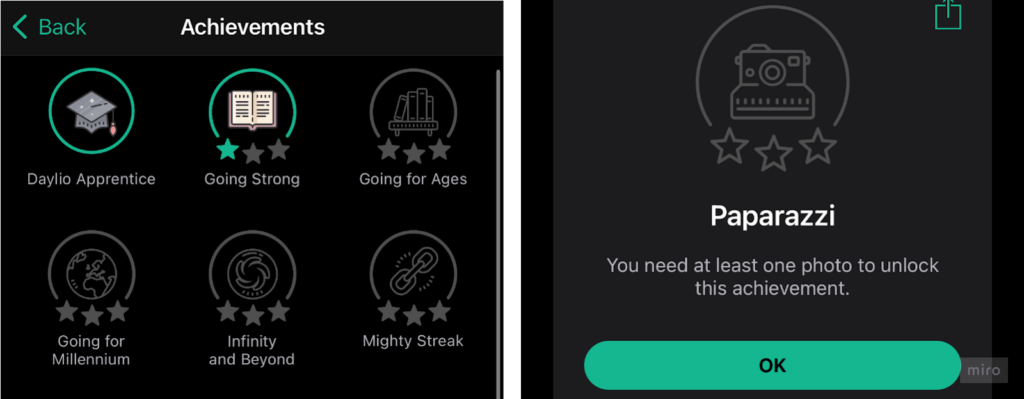
Daylio also lets the user personalize parts of the app, even though the variables to change are not many. They include the color scheme, name, and icon for each mood. Too bad the app doesn’t take it further — neither Me+ nor Daylio uses any rewards. That’s a missed opportunity to guide the user along their goals by offering something extra, such as new icon sets. There are plenty of users that would love to be able to earn a poop emoji for the day that sucked.

One criticism we have about Daylio is it comes across as a serious app because it offers serious content. It relies on organic discovery and works for users who mean business — as we see in the long-term retention, but that audience is small. Adding bling and personal aspects into the onboarding process, or better showcasing features like the progression of each task, could elevate it and help with acquiring more users.
A broader point can be made here about gamification: Too often, apps take the “measurable” elements of games and forget fun and playfulness. Of course, this will depend on the audience of the app, but bringing levity can help the app gain traction with a larger audience. It certainly hasn’t harmed Duolingo.

Conclusion & Key Takeaways
Daylio excels in retaining users for an extended period, which we interpret as an engaging and enduring experience for the users. However, it faces challenges in converting users into premium subscribers and driving significant revenue, partially due to its free-to-use model and limited monetization options and partially due to an overall feature lightness.
Takeaway 1: Context is King
Daylio is all about context. Its goal suggestions are driven by what the user wants to achieve (i.e. better sleep). It connects the dots between the mood and the tasks and habits, thus building a subconscious relationship between them, and helping the user uncover hidden patterns and dependencies.
The visualization of mood logs over time lets the user easily see if they are making progress, and the fact they are linked to health data from the phone adds a level of importance and seriousness to the visualized data.
Takeaway 2: Simplify the Chores But Don't Lose the Depth
The thoroughness of how simply the features can be used speaks well for the developers. The focus on jumping right into the relevant flow for the user’s needs really helps the experience, like in the case of the daily summary that lets the user quickly select their emotional state. In fact, its stellar long-term retention can be partly attributed to both the simplicity of each day’s mood entry and its longer-term visualization.
Takeaway 3: It Takes More to Be Truly Competitive
In a way, Daylio feels like a glorified calendar that sums up the subjective quality of each day. It doesn’t pretend to be more than it is, and its audience appreciates exactly this. Specifically, within the existing market, Daylio comes across as rigid at first, and while it has substance, most users will not discover it, as the value of tracking and pattern discovery only becomes obvious after some time.
This is where gamification could help, even for a “serious” app like Daylio.
Zooming In: Finch: Self-Care Pet
Finally, we get to talk about this truly gamified habit-building app. The app is developed by Finch Care Public Benefit Corporation. To quote from their website: Finch was started by 2 friends (Nino & Steph 🙇🏾♂️🙇🏻♀️) who struggled with anxiety and depression and found self-care challenging to stick with. We decided to build Finch hoping to make self-care fun and accessible after seeing many others share similar struggles.
That reads as wholesome. And we will see throughout this section that if there’s one word for Finch, it’s that. This doesn’t mean we won’t be critical, but we can still praise the creators for their intentions.
Finch effectively appeals to users who enjoy gamified experiences, enhancing engagement and providing a sense of progression. D1 retention is almost 60%, similar to Daylio, but Finch has almost double the RPD ($1.11 versus $0.69).

The app has been out since 2021, and in that period it garnered 8.42M downloads and $9.19M in revenue. In habit-building, these numbers are very good, particularly its downloads, as it sits in sixth position for 2023 downloads in the Mental Health category.

In the heart of Finch is a growth metaphor, which is a very apt (and obvious) one. The user owns a birdie, a best friend who thrives because of their actions in the real world.
Finch stands out not just because it is gamified, but also by how the features interact and support each other and the overarching narrative of self-care.
Finch consists of many features and we could write a whole deep dive just about its loop, so we’ll try to keep it short. We’ll discuss the loop and how Finch connects typical game features to its mission.
Let’s start with the loop.
- The user does what a user does in a habit-building app (creating and completing tasks), which earns them Energy. The pet then undertakes a daily idle adventure that is enabled by this resource.
- Pet activity earns a soft currency called Rainbow Stones, which can be spent in the store for customization features.
- Actions in the app are additionally tracked via a Quest system (also rewarded with Rainbow Stones), and daily engagement counts into the Event Pass.
- If the user interacts consistently on a daily basis, the pet grows, which unlocks new modes of adventure and new features.
This is all summarized in the diagram below.
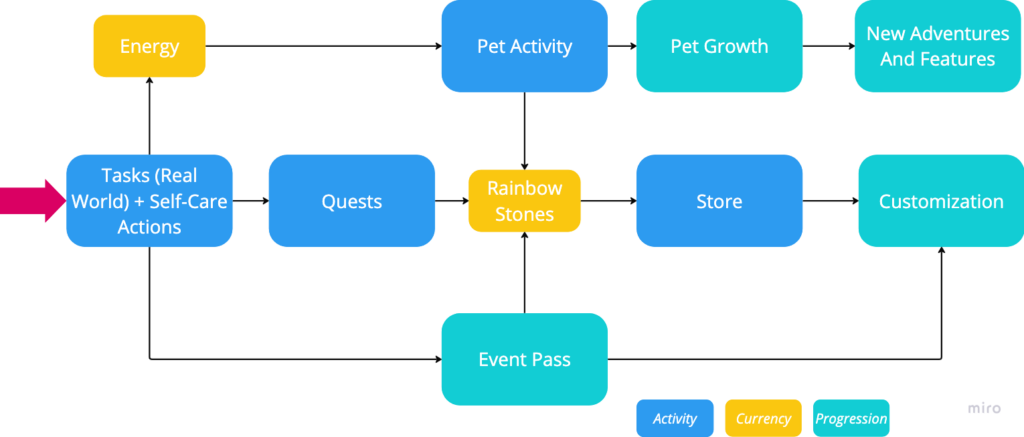
Now we will take a closer look at the most significant features.
The obvious metaphor of taking care of a pet and linking it to self-care speaks to the subconscious mind of the user and establishes the idea of caring about themselves just like they do with a small, harmless bird.
When testing the app, it was surprising how quickly one would assimilate completing tasks with “making the baby bird happy and thriving.” Of course, not everyone will be swooned by this, but it’s a valid and functional crutch the user can lean against when trying to change their life.
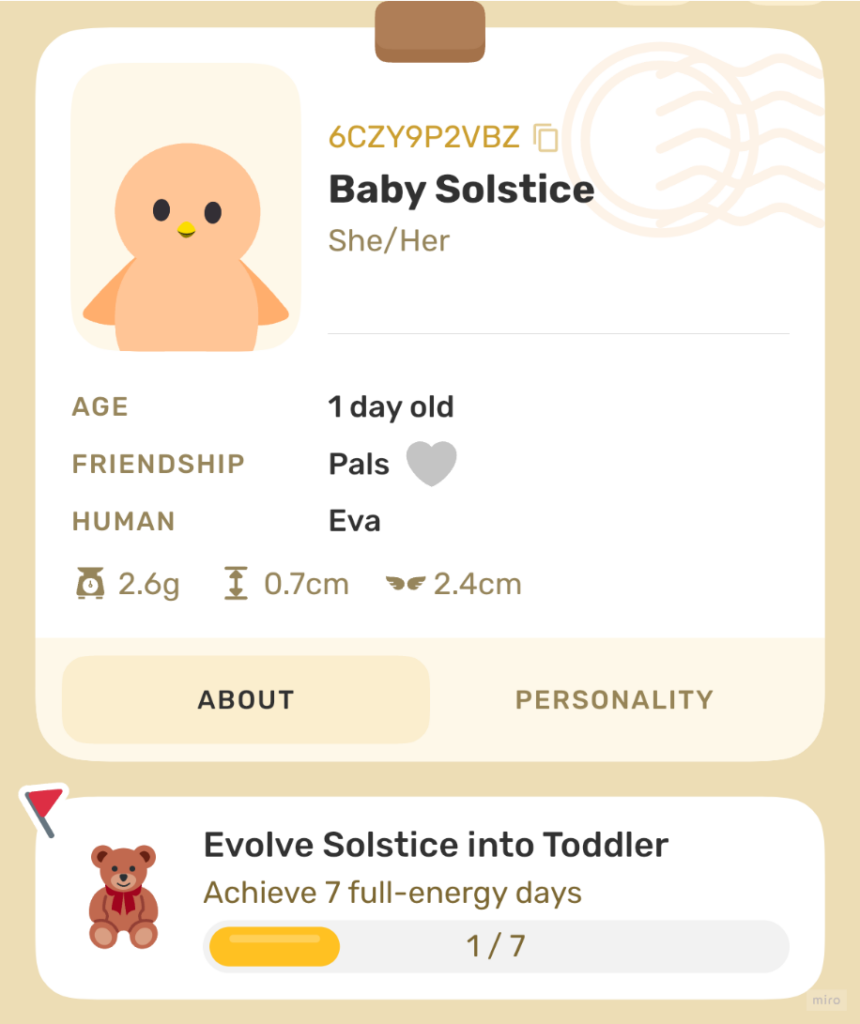
The app foreshadows the progress the user can gain, by attaching numerics to the pet (size and weight, like a newborn baby) and explaining what persistent activity unlocks. These range from new locations to even pets having their own pets. Instilling this curiosity in the user is a proven way of helping them form goals.
The real deal, as we already made clear earlier, isn’t the progression mechanics themselves. Just like in games, we need rewards, which in Finch take the form of customization. We should point out that these rewards work as a secondary motivation, and don’t hold any strong conversion power themselves. The intention is to have a broad enough reward space to keep the users interested and to incentivize them — especially subscribers — regularly.
Finch uses two kinds of customizations: clothes for the pet and furniture for its house.
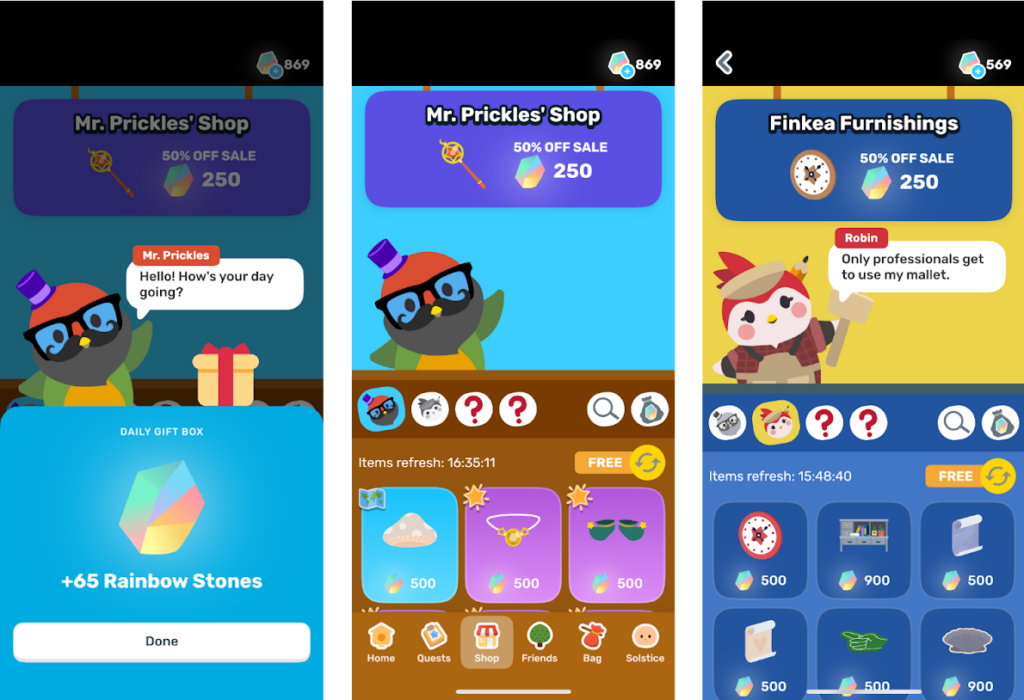
Users use Rainbow Stones to purchase these customizations, and these are earned by the pet going on adventures, completing Quests and progressing through the Event Pass (a battle pass that progresses based on completing daily tasks).

One extra neat feature is the Widget, which can be placed on the iOS main screen. It serves as a constant reminder of the app and the changes happening within. If there’s an activity your pet wants the user to engage with, the widget will say so. The app will toy with the user’s curiosity and show different statuses to check out.

Finch also builds on social features to boost virality. For one, inviting friends is one of the more prominent sources of Rainbow Stones. The app doesn’t forget about social cohesion either. Friends can be added to the Tree Town, a virtual village, send emojis for support, and be included in the tasks (“Plan a dinner with…”). It’s a good example of how to merge real-life with the app, and how by following the app's suggestions, one's mental state can improve.
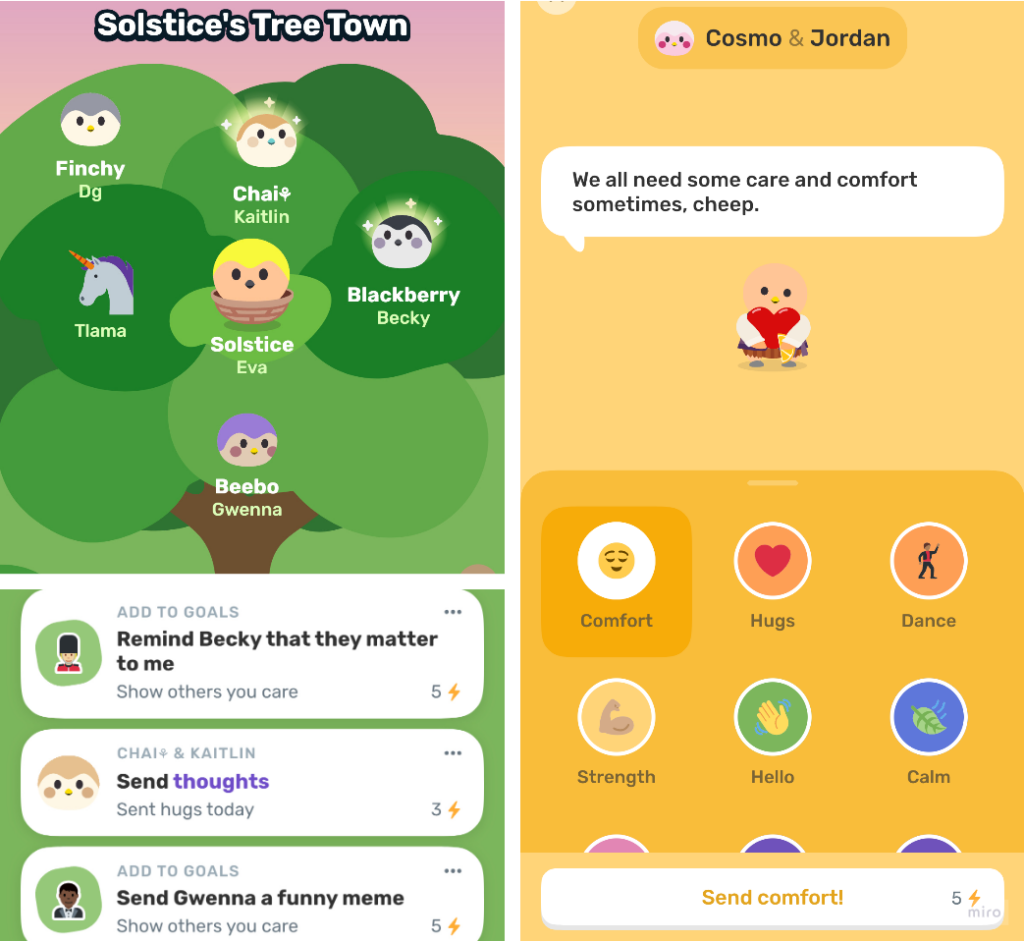
In terms of areas for improvement, one to mention first is a certain staleness over time. Where the pet-care metaphor helps motivate early on, it may not feel exciting enough later, as users get accustomed to the high level of engagement (compared to other habit-building apps). It’s not a mistake to keep the metagame light, but users will see the promise they are given early on and will expect things to remain exciting, just like in games. Finch makes an attempt by introducing collections as one of the long-term goals — the pet finds items on their daily journeys — but in the grand scheme of things, it’s not a very attractive or exposed feature.
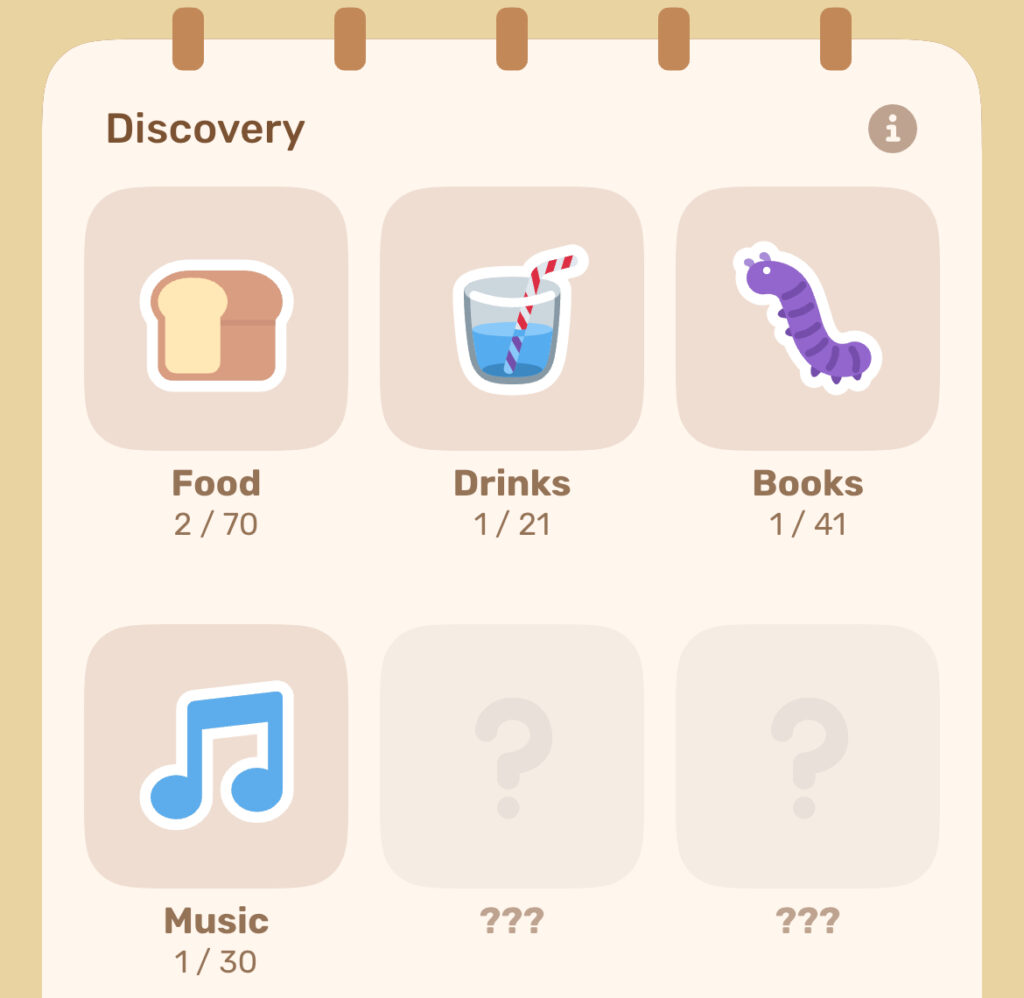
Second, while it may be counterintuitive to think about IAPs in a self-care app like this, we do see a case for hard currency for purchasing special items and gifting within the social layer.
Overall, Finch is a solid app not because it’s gamified, but because it is gamified really well. The developers understand behavioral psychology, but choose to communicate it playfully, rather than praise themselves for using science. And it’s really satisfying to see the effort of its creators play out well in the market.
Conclusion & Key Takeaways
Takeaway 1: The Metaphor Matters
Habitica and its RPG metaphor work for people who are well-versed in games, but ultimately, the metaphor doesn’t fit the goal of the app (habit-building). In Finch, the goal of self-care synergizes with the level of care represented by the pet. Picking the right metaphor is crucial in ensuring that the gamified layer is aligned with the app’s true purpose.
Takeaway 2: Follow the North Star
Finch's strength lies in its ability to seamlessly integrate gamification features that align with the core mission of the app. Every feature seems to be integrated with the core idea of kindness toward yourself and others.
For example, the setup of the Event Pass with progress determined by daily task completion is not arbitrary; it directly supports the app's fundamental objective of building habits.
Or how, every now and then, the app asks the user how they feel. If they don’t feel great, the energy income increases to compensate for the actual low energy coming from a bad mood.
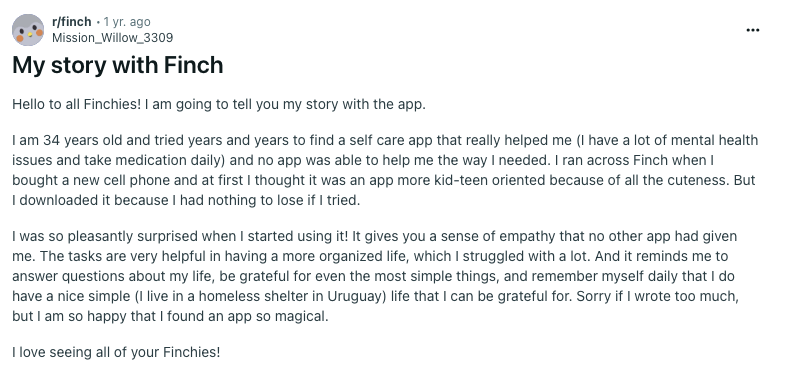
To choose gamification means committing to it fully.
Takeaway 3: Hide the Magic
Even though science and psychological principles underpin the app's design, users are not overwhelmed with the technical details. Finch shows that effective gamification isn't solely about science, but it's about making the process enjoyable and accessible to all, regardless of their familiarity with the underlying principles.
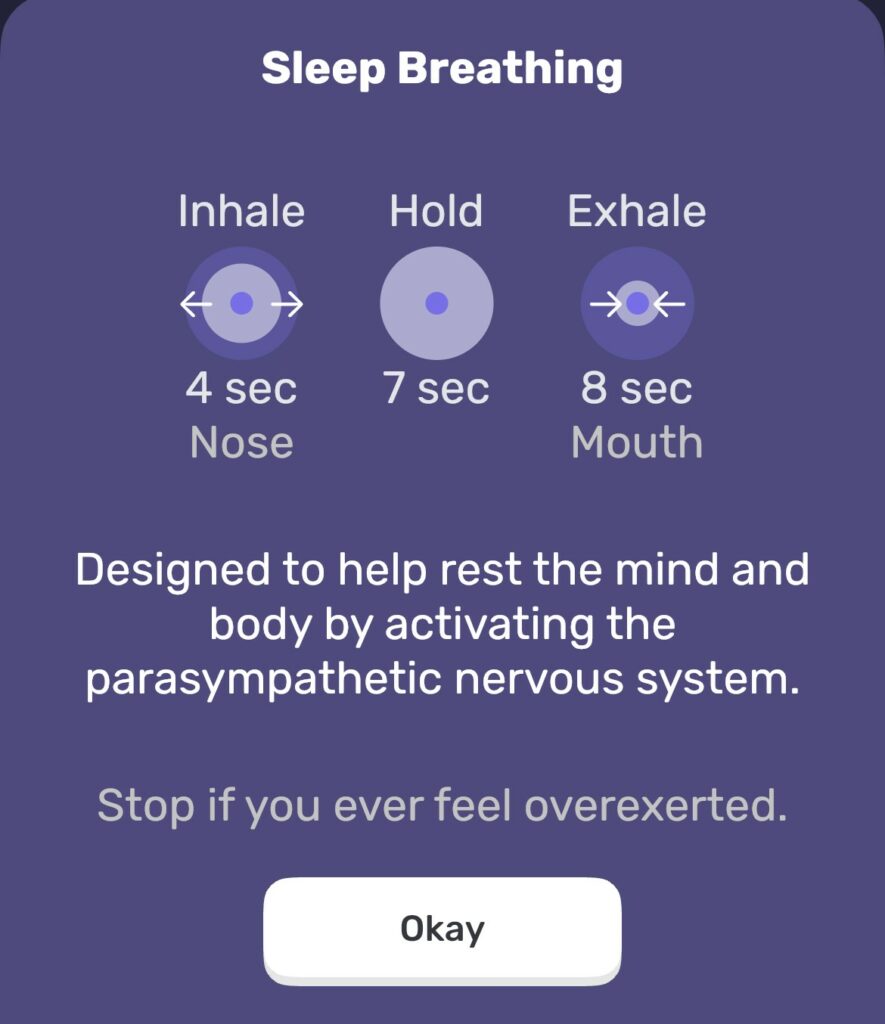
Finch rewards the user for trying different things out by tying it into the core loop. In the example below, the user earns energy for self-reflection that translates into the pet's adventure which translates into its growth.

This approach will not benefit everyone, and a certain portion of the audience will always crave more serious experiences like Daylio, even if the science in the background is exactly the same. But Finch is proof that gamification can encapsulate this science and further emphasize it by features that are lighthearted, playful, and more accessible.
Recipe for Building a Gamified Habit-Building Super App
The broad question we have been trying to answer in these case studies is whether it is worth it to double-down on gamifying habit-building.
Developing an app that intends to help people bears different responsibilities than a game. You have to understand both games and the psychology behind behavioral change. If you propose a metagame or stick to features that aren't compatible with your core mission, you will lose users.
A real risk within the gaming metaphor is the thin line between the app’s gamified goals and the user’s real ones. Pushing the game metaphor too much may mean the users identify too strongly with the game’s goals and forget their primary purpose.
However, even with these reservations, we are convinced it is absolutely worth it to gamify when you have the right intentions. The proof is when comparing Finch on one hand and Me+ and Daylio on the other. Gamification in Finch helps elevate the habit-building experience, and enables to communicate the core mission — being kind to yourself for taking one step at a time — on many different levels within the app, be in interactions in the virtual world of the pet, or the constant sense of progression built purposefully into the metagame’s systems.

That doesn’t say we can’t find inspiration in the other two apps, or in a broader perspective within the other examples we used. For that, let’s aggregate the learnings from our three apps into a recipe:
Ingredient 1: Clear and Rewarding Habit-Tracking System
Begin with a robust and user-friendly habit-tracking system. Users should be able to easily define and input their habits, set goals, and track progress. Build systems that reward the users for persistence.
We were inspired:
- Zombies, Run: Gamified progression can be as simple as unlocking pieces of a story through core loop interaction.
- Daylio: Predefined groups of tasks that correspond with typical user objectives can help give them a sense of direction right from the start.
- Daylio: Tracking progression on each task rewards the user for persistence and repetition.
- Finch: Committing to tasks right in the onboarding gives the user something to achieve immediately .
Clear user experience is king, and simplifying the chore part of the app’s navigation is crucial.
Ingredient 2: The Metaphor Should Align With the Core Mission
Implement gamification elements with care and thoughtfulness. Ensure that gamified features align with the core mission of the app and fit narratively and metaphorically together, and spice the user journey with playfulness to make it more fun and simpler to adopt.
We were inspired:
- Forest: The way the pomodoro app communicates how productive the user was over time could be adapted to habit-building, too. Giving the user more granular feedback for their efforts (like Daylio, but through a metaphor) doesn’t have to be costly to develop, and can significantly boost retention.
- Daylio: Scientific, measurable approach to habit-building aligns well with the app’s straightforward UX and focus on clear goals.
- Finch: Next to everything we already said, one of Finch’s strengths lies in teaching the user to look forward to using the app because it implements random encounters and rewards into the pet’s adventures. Non-gamified habit-building can feel too predictable; playing with randomness can bring the same advantages as using it in games.
In the longer term, treat the metaphor as a metagame that feeds into the core actions much like the core actions feed into the metagame.
Ingredient 3: Measurements and Interpretations
Integrate the phone’s health-tracking features: step counters, sleep tracking, and other health-related data sources. This data can be leveraged to provide users with a holistic view of their well-being and align it with their habit-building progress. If possible, draw conclusions and suggest actions in order to improve their state.
We were inspired:
- Daylio: Utilizing available data and displaying relations between mood and, for instance, sleep quality is the first step toward suggestions.
Ingredient 4: Mid- and Long-Term Goals
Bring in meaningful goals that will drive retention. In the example below from Yoga Go, the user can select what they want to focus on.
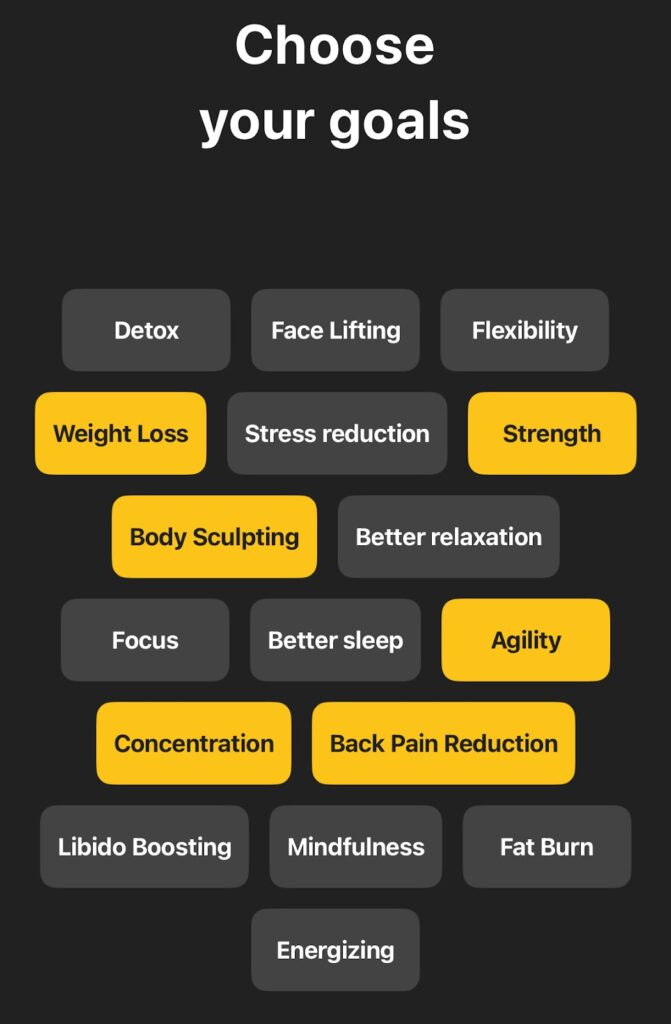
Here, habit-building apps bear a disadvantage against other apps, like fitness or weight-loss tracking. A goal to reach is hard to define, as the definition of long-term success will mean different things to different users. Someone may want to keep to their tasks, another to feel great long-term.
The solution here is to use the general well-being recipe that these apps already implement and use them as a ground for longer-term goals. For instance, progression in areas like sleep quality, exercise per week, healthy/fast-food ratio, mood… etc.
We were inspired:
- Daylio: The system of achievements serves as a goal system, albeit very light.
- Finch: For medium-term goals, Finch uses the pet’s pets as an extra level of commitment. The user can link a task important to them with an extra progression, like hatching an egg.
- Fitness and weight-loss apps let the user choose their goals. It’s then easy to refer to the goal with every new datapoint (completed exercise, stepping on the scale).
Where it’s hard to define interesting goals, gamification can help boost curiosity necessary to stay engaged long-term because it comes with extra systems of rewards. One example would be seeing your pet mature in Finch, and another one is the gradual story unlock in Zombies, Run. Both set the user up for a long-term engagement, giving them enough information to understand that it’s worthwhile to keep retaining.
Ingredient 5: Running an App Like Running a Game’s LiveOps
Commit to providing regular content updates; basically, run live-ops. They not only maintain user engagement but also encourage long-term commitment to the app. Users anticipate and enjoy the continual growth of content and features. This way, you keep the users invested in the app, rather than seeking alternatives elsewhere.
We were inspired:
- Running apps let the users commit to tracking long distances, and often link them with competition or social media to boost the engagement even more.
- Finch: The Event Pass, borrowed from games, works well in a habit-building app, as it can reward the user for each day they are active in the app.
Ingredient 6: Integrating Social Features
Foster a sense of community through social integration. Allow users to connect with friends, share achievements, and engage in friendly competition or collaboration.
- Finch: Allowing users to connect with friends fits really well with the app’s core idea, and helps with virality.
- Short-term social challenges in games match the players into a cohort without them needing to be part of any social group. Based on the data provided, apps can link users together and provide competition or cooperation opportunities, thus making the app feel more alive.
Ingredient 7: Embracing Personalization
Habit-building apps try to hit many birds with one stone. Without customizing the content based on user surveys or data, potential user stories can be missed out on. The users may get lost in the overwhelming amount of options without sufficient guidance (like in Me+), or fail to respond to generic notifications that do not take into account their personal rhythm of the day.
In that sense, these apps could certainly benefit from a more dynamic approach. Dynamic personalization, much like dynamic balancing in F2P, will be able to recommend suitable habits based on user profiles, or adapt the content and actions of the app in real-time as users engage with it.
Especially with the growing abilities of AI, it’s natural to expect that its power will change the landscape of mental health and mental health apps. It may take a while for it to actually diagnose patients, but being able to analyze patterns and link them to specific suggestions is within today’s AI capabilities.
Some areas to suggest:
- Content Personalization
- Customized Habit Recommendations: Analyze user data, behavior patterns, and goals to suggest habits that align with their specific objectives and preferences. The app should learn from user interactions and adjust recommendations accordingly.
- Tailored Educational Content: Provide personalized educational content related to habit formation, behavioral psychology, and well-being. Users may receive articles, videos, or tips that match their current progress, challenges, and interests.
- Action Personalization
- Adaptive Reminders: Customize reminder schedules and frequencies based on user habits and preferences. For example, if a user is more likely to exercise in the morning, the app can adjust reminder timings accordingly.
- Dynamic Challenges: Create challenges and milestones that evolve as users make progress. AI can adjust the difficulty of challenges to maintain the optimal level of motivation and engagement for each user.
Final Remarks
In this deep dive, we set out to evaluate several habit-building apps that each stands out in a different way, and to seek the qualities gamification can offer beyond mere functional engagement with an app. We aimed to point out their strengths and weaknesses and amalgamate them into a functional recipe for a gamified habit-building app.
It can be tempting to see gamification as a copy-and-paste job, but that would be a mistake. We see in the example of Finch that bringing these ideas to life takes substantially more commitment. One may even feel that gamification is a risky venture not worth the extra investment. In some ways, adding gamified features does mean committing to a long-term journey, and that can feel like a lower priority than adding a single feature to uplift a specific metric.
But time and time again, we see that if gamification is done right, such as in Finch or Duolingo, it is worth it for both the user and the developer.
A Big Thanks to Our Partners
This essay and all of Naavik’s freely available research wouldn’t be possible without the support of our Open Gaming Research Initiative partners. Learn more about them here.
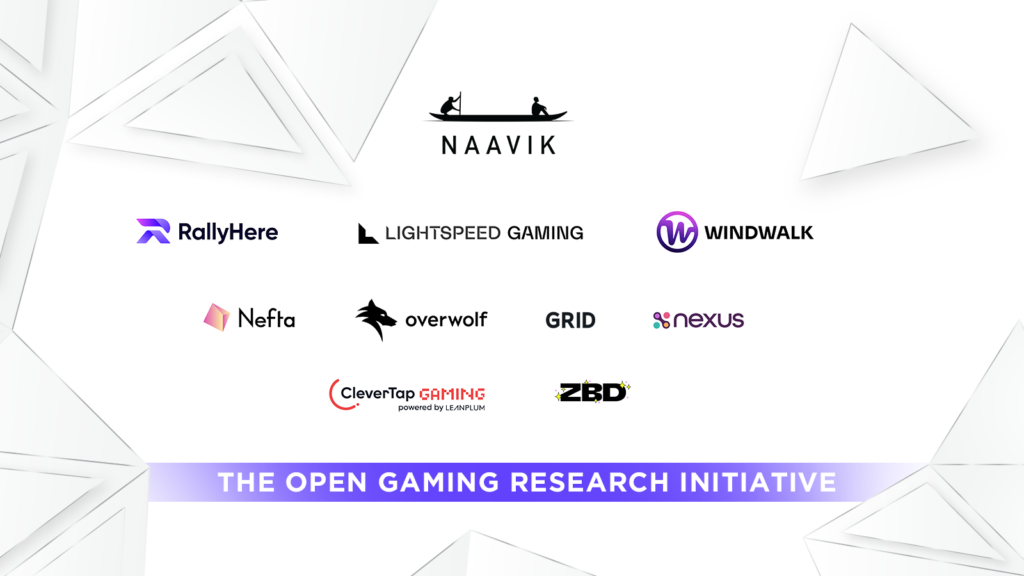
Naavik has helped 250+ games teams with game & economy design, market research, user acquisition, and more. If interested in how Naavik can help your team, make sure to learn more and get in touch.








